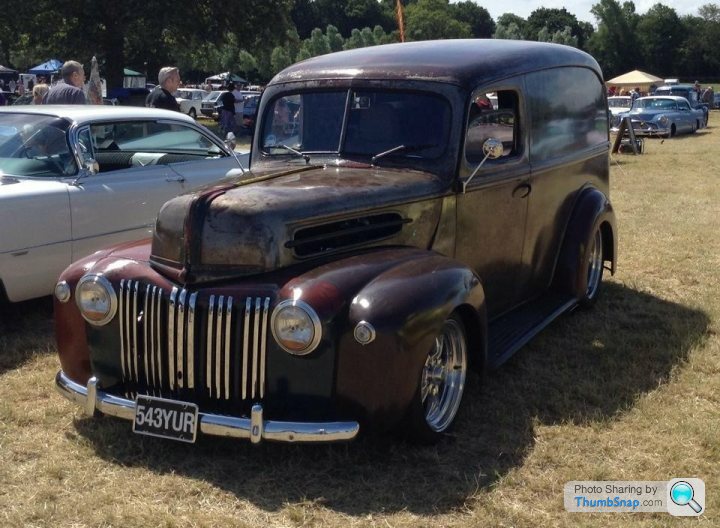Hot rods, street rods, kustoms and a few other things
Discussion
Following some ramblings on the "photos of decently modified cars" thread it seemed like a good idea to stop polluting that thread and start a new one, so here we are.
The intention is I'll add posts to the thread as it goes along on stuff related to hot rods and the culture. In no particular order we'll cover the cars themselves, some history, influences and some of the important people over the years.
I should add that I'm no authority on all of this, there are people out there that are far more informed than I, hell some of the people and cars that we'll cover are still around ! So, if I get anything wrong please do correct me. I'll also quote sources for further reading when relevant.
By all means ask questions or if you have suggestions on what you would like to read about post a reply.
So, first of all a difficult question.. what is a hot rod ?
Its a question that usually starts arguments, "its gotta have 3 pedals", "gotta be pre-48", "gotta be steel" people will say.
The short of it is there is no strict definition of a hot rod, in a very broad sense your local chav saxo is a hot rod, now that would be a controversial thing to say!
One thing for sure, the definitive hot rod is the '32 Ford roadster. We'll go over some of the cars in a later post, but for now just look how timeless this is..
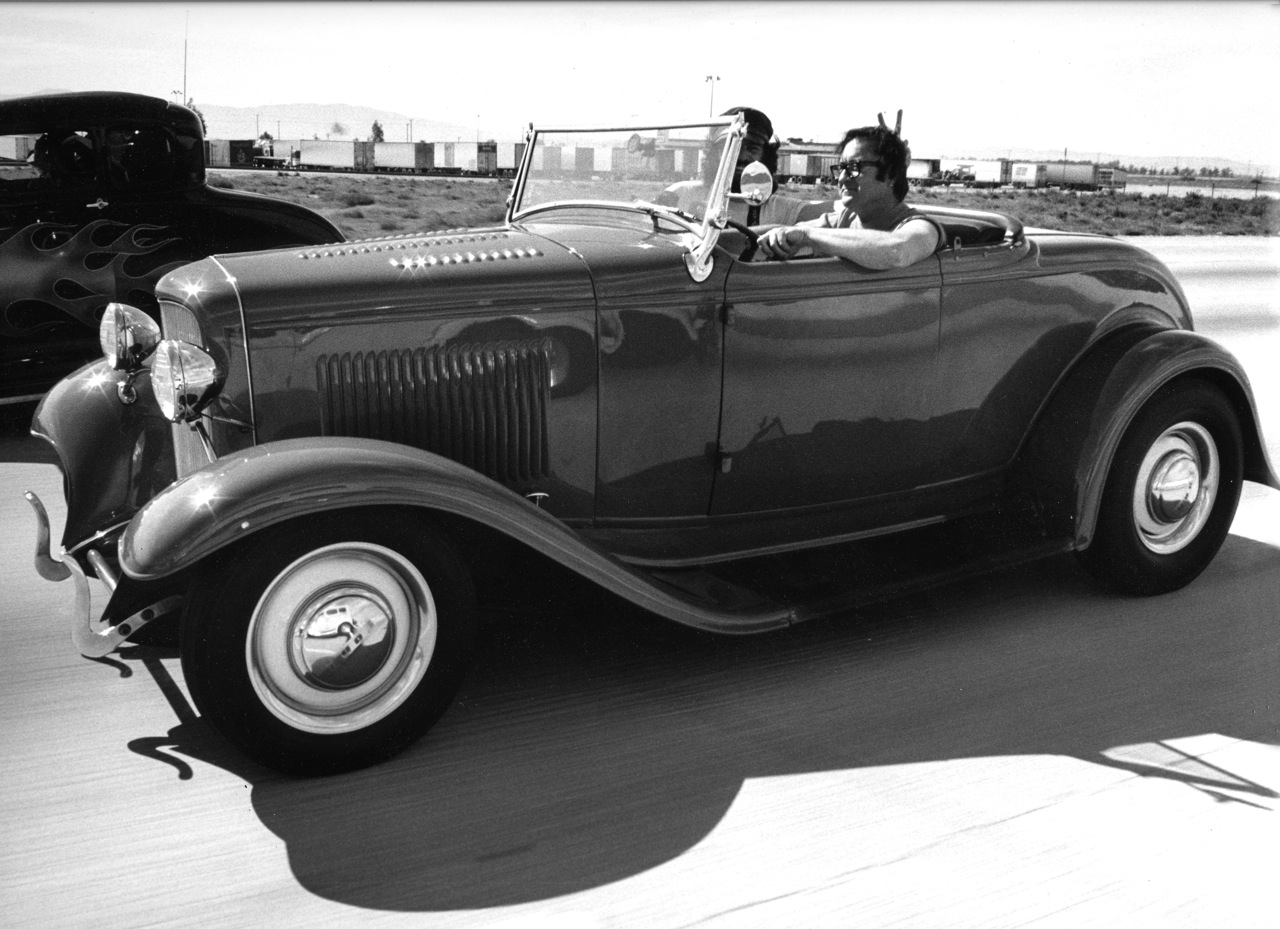
Gray Baskerville driving his '32 Ford roadster in 1977
Where does the term hot rod come from ?
That isn't too clear either, we know its a post war term. In the 20s and 30s the cars were known as gow jobs, in this period to call someone's car a hot rod or someone a hotrodder was offensive. Hotrodders were hoodlums, bad news.
This is from a 2001 issue of street rodder that explains the origins of gow job
Some say it comes from stroked engines - Stroking an engine involved replacing the connecting rods for longer ones, giving the engine more displacement, when the work was done the car had been hot rodded. A similar explanation is given but the hot rod part referring to an upgraded camshaft...
Gray Baskerville (life long hot rodder and hugely respected journalist, known as old Dad to millions) has possibly the easiest explanation - most cars being hot rodded were roadsters, the modifications made them hot and roadsters got shortened to rod. Hot rod.
So, we need to go back to gowjobs to find our start.

A gowjob
Since the invention of the automobile people have raced them. In 30s and 30ths american it was no different, specifically in the sunny climes of California young guys wanted to race, so they'd go out to the dry lakes of Muroc and El Mirage and try and go faster than everyone else. This particle is post war but shows young guys doing much the same thing: http://books.google.co.uk/books?id=r0wEAAAAMBAJ&am...

The cars were stripped of anything that might slow them down - the huge canvas roofs removed, the plate glass windshield unbolted, the fenders consigned to the scrap bin. As time progressed the engines were fettled - bigger carburettors, more efficient intakes, higher lift camshafts.
Fords were popular, because they were cheap cars - they're still very popular today. Back then it was model T Fords, then the model A and finally the model B which was somewhat of a watershed. The cars would take a run up and would then be timed over a set distance once up to speed. In 1937 the South California Timing Association was formed, they sought to set some rules as to how events would be run, improve safety and standardise the rules. SCTA still organise and run events on the dry lakes, and of course Bonneville.

The lakes weren't the only race venues, dirt track racing was taking hold in cars like this, known as midget
Then ? well, some German upstart got in the way didn't he ?. Car production simply stopped in 1942, the factories turned over to the war effort.
Late 1945 car production started up again, the manufacturers just picked up their 1942 designs and put them in to production. The good people of America were encouraged to spend their money, this meant older cars were cheap.
Another effect the war had was that the guys who were trying to build aftermarket parts (or speed equipment as it was known) had gain engineering knowledge and experience whilst building aeroplanes, tanks and all sorts of other vehicles. They took this knowledge and applied it to the parts they created.
The other effect the war had was the quest for adventure. Young guys, back home from the war had money in their pockets and found domestic life boring. Spending their money on "hopping up" an old jalopy was fun, so was racing it at stop lights on the streets. It was common to find racing on a Friday/Saturday night on the "main drag" in towns all over the country.
This, predictably led to accidents and deaths. Slowly all over the country "drag strips" appeared, where you could race relatively safely. the problem was there was no unified structure, you could run in a class in California but travel 100 miles and the car was ineligible because the rules were different.
Enter then editor of Hot Rod magazine Wally Parks. He could see the problems and was concerned about the varying safety rules at different strips, so he used his contacts and influence to form the NHRA, they defined a standard set of rules and class definitions, soon tracks all over the country became affiliated and drag racing as a sport (rather than a hobby) was born.
One of the earliest tracks was Santa Ana, a few pictures and info here : http://selvedgeyard.com/2009/05/25/1950-1959-the-s... Effectively at this stage the tracks were mostly doing what we now call "run what ya brung", you turned up, paid a small amount and ran your road car up the strip.
This is a bit cheesy, but is a typical "road safety" video of the time to try and encourage kids to go racing instead of racing on the streets. https://www.youtube.com/watch?v=cUynqZoOTlA
Thats a start, so keep an eye out, those hoodlums are still around:

I'd guess sometime in the early 50s, 4 guys sit on a 5 window Model A

Mid 50s Ford Model T

32 Ford 3 window dry lakes car from early/mid 50s. This car is the real thing, raced in the 50s, it was restored in 2006
The intention is I'll add posts to the thread as it goes along on stuff related to hot rods and the culture. In no particular order we'll cover the cars themselves, some history, influences and some of the important people over the years.
I should add that I'm no authority on all of this, there are people out there that are far more informed than I, hell some of the people and cars that we'll cover are still around ! So, if I get anything wrong please do correct me. I'll also quote sources for further reading when relevant.
By all means ask questions or if you have suggestions on what you would like to read about post a reply.
So, first of all a difficult question.. what is a hot rod ?
Its a question that usually starts arguments, "its gotta have 3 pedals", "gotta be pre-48", "gotta be steel" people will say.
The short of it is there is no strict definition of a hot rod, in a very broad sense your local chav saxo is a hot rod, now that would be a controversial thing to say!
One thing for sure, the definitive hot rod is the '32 Ford roadster. We'll go over some of the cars in a later post, but for now just look how timeless this is..

Gray Baskerville driving his '32 Ford roadster in 1977
Where does the term hot rod come from ?
That isn't too clear either, we know its a post war term. In the 20s and 30s the cars were known as gow jobs, in this period to call someone's car a hot rod or someone a hotrodder was offensive. Hotrodders were hoodlums, bad news.
This is from a 2001 issue of street rodder that explains the origins of gow job
Street Rodder said:
"They used the terms hop-up or gow job. So where did these come from? Well, "hop" and "gow" were names for opium which were in use as far back as the late 1800s and probably came from the Chinese. In the old days they improved the performance of race horses with drugs including opium and cocaine. This was not even illegal until the early '20s and continued surreptitiously after that. Even today the performance enhancement of human athletes and horses is nor unknown.
A horse that went faster than it had any right to, was said to be 'hopped-up" or "gowed-up". From there it was a short step to apply the same names to a souped-up car. By the way, human drug users got the same names. If you read a few hard-boiled detective stories from the '30s and '40s you will soon find reference to "hopped-up punks" and "gowed-up hoodlums."
As far as "soup" goes, in the '20s, nitroglycerine was called "soup" in the under-world. It was not easy to get -- safe crackers had to extract it from dynamite. It was all illegal substance and possession was evidence of criminal intent, like burglar tools. Hence the code name. "souped-up" probably referred to a race car running on exotic fuel. I know that in the '20s it was possible to buy special racing fuel from the big oil companies. An old-time motorcycle mechanic told me of taking a can of such fuel to the races where his employer had bikes competing, then pouring the leftover fuel into the tank of his hopped-up Ford, and how fast it went on the way home.
In the '50s they began to use nitromethane, which is a close relative of nitroglycerine. Small world. By that time "souped-up" had acquired the general meaning it has today and hot fuel users coined new terms like "pop" and "nitro."
So gowjob can be explained in a reasonably sensible manner, but hot rod ?A horse that went faster than it had any right to, was said to be 'hopped-up" or "gowed-up". From there it was a short step to apply the same names to a souped-up car. By the way, human drug users got the same names. If you read a few hard-boiled detective stories from the '30s and '40s you will soon find reference to "hopped-up punks" and "gowed-up hoodlums."
As far as "soup" goes, in the '20s, nitroglycerine was called "soup" in the under-world. It was not easy to get -- safe crackers had to extract it from dynamite. It was all illegal substance and possession was evidence of criminal intent, like burglar tools. Hence the code name. "souped-up" probably referred to a race car running on exotic fuel. I know that in the '20s it was possible to buy special racing fuel from the big oil companies. An old-time motorcycle mechanic told me of taking a can of such fuel to the races where his employer had bikes competing, then pouring the leftover fuel into the tank of his hopped-up Ford, and how fast it went on the way home.
In the '50s they began to use nitromethane, which is a close relative of nitroglycerine. Small world. By that time "souped-up" had acquired the general meaning it has today and hot fuel users coined new terms like "pop" and "nitro."
Some say it comes from stroked engines - Stroking an engine involved replacing the connecting rods for longer ones, giving the engine more displacement, when the work was done the car had been hot rodded. A similar explanation is given but the hot rod part referring to an upgraded camshaft...
Gray Baskerville (life long hot rodder and hugely respected journalist, known as old Dad to millions) has possibly the easiest explanation - most cars being hot rodded were roadsters, the modifications made them hot and roadsters got shortened to rod. Hot rod.
So, we need to go back to gowjobs to find our start.

A gowjob
Since the invention of the automobile people have raced them. In 30s and 30ths american it was no different, specifically in the sunny climes of California young guys wanted to race, so they'd go out to the dry lakes of Muroc and El Mirage and try and go faster than everyone else. This particle is post war but shows young guys doing much the same thing: http://books.google.co.uk/books?id=r0wEAAAAMBAJ&am...

The cars were stripped of anything that might slow them down - the huge canvas roofs removed, the plate glass windshield unbolted, the fenders consigned to the scrap bin. As time progressed the engines were fettled - bigger carburettors, more efficient intakes, higher lift camshafts.
Fords were popular, because they were cheap cars - they're still very popular today. Back then it was model T Fords, then the model A and finally the model B which was somewhat of a watershed. The cars would take a run up and would then be timed over a set distance once up to speed. In 1937 the South California Timing Association was formed, they sought to set some rules as to how events would be run, improve safety and standardise the rules. SCTA still organise and run events on the dry lakes, and of course Bonneville.

The lakes weren't the only race venues, dirt track racing was taking hold in cars like this, known as midget

Then ? well, some German upstart got in the way didn't he ?. Car production simply stopped in 1942, the factories turned over to the war effort.
Late 1945 car production started up again, the manufacturers just picked up their 1942 designs and put them in to production. The good people of America were encouraged to spend their money, this meant older cars were cheap.
Another effect the war had was that the guys who were trying to build aftermarket parts (or speed equipment as it was known) had gain engineering knowledge and experience whilst building aeroplanes, tanks and all sorts of other vehicles. They took this knowledge and applied it to the parts they created.
The other effect the war had was the quest for adventure. Young guys, back home from the war had money in their pockets and found domestic life boring. Spending their money on "hopping up" an old jalopy was fun, so was racing it at stop lights on the streets. It was common to find racing on a Friday/Saturday night on the "main drag" in towns all over the country.
This, predictably led to accidents and deaths. Slowly all over the country "drag strips" appeared, where you could race relatively safely. the problem was there was no unified structure, you could run in a class in California but travel 100 miles and the car was ineligible because the rules were different.
Enter then editor of Hot Rod magazine Wally Parks. He could see the problems and was concerned about the varying safety rules at different strips, so he used his contacts and influence to form the NHRA, they defined a standard set of rules and class definitions, soon tracks all over the country became affiliated and drag racing as a sport (rather than a hobby) was born.
One of the earliest tracks was Santa Ana, a few pictures and info here : http://selvedgeyard.com/2009/05/25/1950-1959-the-s... Effectively at this stage the tracks were mostly doing what we now call "run what ya brung", you turned up, paid a small amount and ran your road car up the strip.
This is a bit cheesy, but is a typical "road safety" video of the time to try and encourage kids to go racing instead of racing on the streets. https://www.youtube.com/watch?v=cUynqZoOTlA
Thats a start, so keep an eye out, those hoodlums are still around:

I'd guess sometime in the early 50s, 4 guys sit on a 5 window Model A

Mid 50s Ford Model T

32 Ford 3 window dry lakes car from early/mid 50s. This car is the real thing, raced in the 50s, it was restored in 2006
Hello Streetrodder, yes I remember you posting a picture of your project before, 34 3w right ?
Do post updates of the build, it'll give us all some insight to an early coupe.
I did write out a post last night showing the different Fords from the 30s, but its kind of pointless really, all you need to know is the year.
To encourage owners to change their car often manufacturers changed the cars every year, this still goes on to this day in the American market.
So, you can identify a car by its year, '33 Ford Coupe for example. Due to their popularity "Ford" is often dropped, so if someone says they have a '36 Sedan they mean a Ford. If they have any other make it'll be specified.
One thing to watch for with '38-40 Fords is that they had two models, Standard and Deluxe. The models weren't new, but in '38 they actually changed the sheetmetal around the grille area. The Deluxe became the next years Standard model sheetmetal.
All manufacturers in the 30s stuck to these basic body styles:
Roadster - convertible roof, windshield is usually bolted on
3 Window Coupe - 2 door, hardtop. 3 Window refers to the number of windows (excluding the windshield)
5 Window Coupe - 2 door, hardtop. Again 5 Window refers to the number of back and side windows.
Sedan - 2 door, hardtop. Has a rear seat and little or no boot space. There are variations, you'll hear "humpback" and "slantback" - they are pretty descriptive terms.
The humpbacks have a bigger trunk (or boot as we'd call it) that stick out in to the side profile of the car.
4 door, sometimes nicknamed "moredoor". Basically a sedan but with 4 doors.
Cabriolet - A coupe with a convertible roof, windshield is part of the body and it'll have roll up windows (unlike a roadster).
Phaeton - A four door sedan with a convertible top, no side windows (at all).

'32 Sedan with a small block chevrolet
Not all manufacturers made all styles, but you get the idea.
Some manufacturers (Ford specifically) did make both 3 window and 5 window coupes, why ? I'm not really sure. The 3 window was more considered "sporty" and is probably a bit more desirable now. 5 windows had a little more space inside.
If you google the terms (e.g. "35 3 window coupe") you'll find countless pictures. Try it with other manufacturers too (chevrolet, pontiac, packard etc).
Back to the '32 for a moment.. as I said, considered by many to be the definitive hot rod. The car was very popular at the time, it was the first year for Ford's flathead V8 engine, released as a 3.6 litre, 65 horsepower engine it survived until 1953 in various forms when it was replaced by the Y-block overhead valve engine.
In 1932 V8 engines were nothing new, Cadillac had been making them since the mid teens but this was the first time that a V8 had been made available to the working class.
Hot rodders, racers (at the lakes or on the track) loved them, as did the bootleggers who'd strengthen the suspension and create hidey holes for their jars of moonshine and then use the flathead power to outrun the cops in order to deliver their goods to speakeasys.
Deuce is a term used for '32s as well (cos of the 2 in the year). Hence the Beach Boys "Little Deuce Coupe", the song is all about a hot rod '32 and racing.. the engine is stroked & bored, both referring to increasing the displacement of the engine, 4 on the floor means its got a manual 4 speed transmission (US term is stick shift).. http://youtu.be/ZXFFLuoaMzM
Henry Ford (like everything) oversaw the development of the flathead. There are books on the man and the story of his company but in short at best he was awkward to work for, at worst he was an anarchist. He had rival development teams working on the V8 engine idea. He told one that the engine shouldn't have a water pump, another that it shouldn't have an oil pump. The reasoning was that these were complicated/expensive things to manufacture, he wanted something cheap and simple to make.
He eventually rescinded on both of these points when engineers proved the engine would simply not be reliable without them.
The flathead was a monoblock design, the valves recessed into the block itself, the heads were just a flat block of cast iron with a small recess for the valves (hence the engine name). All this meant that virtually all the machining was in the block itself. Much simpler than engineering a conventional cylinder head.

Early flathead Ford engine and transmission
By comparison Chevrolet had moved to straight six cylinder engines in 1929 and didn't produce a V8 until the ubiquitous small block chevy was released in 1955.
One of the reasons you'll hear quoted for the pre-49 cut off is because in '49 Ford released an all new car that was quite a departure, it didn't have bolted on fenders, the body was one piece, much like cars now.
Soon, the term "shoebox" was coined, the term really applies to the 49-52 Fords but some use it generically for all early 50s cars.

'49 Ford 'shoebox'
So with the influence from drag, track and dry lake racing in terms of engine power and speed these things also influenced hot rod styling. Pretty early on racers figured out junking the bumpers, fenders (wheel arches) and running boards gave both a weight and aerodynamic advantage. The next thing was the big flat windshields, obviously not good for aerodynamics racers soon started chopping their cars. To chop a car you simply cut the roof off, remove some of the A/B/C pillars and weld the roof back on again.
Easy, right ?
Well, on early cars where everything is vertical, yes its not too difficult.
But soon the bodies had sloped windshields and more graceful lines at the back of the roof section. This makes a chop much harder, because when you put the roof back on the two parts don't line up. the common way to resolve this is by cutting the roof in half, then the front can be married up with the A pillar and the rear section with the back, then you need to fill in the gap between the two pieces.
The alternative is to lay the a pillar back so it matches the roof. Thats how this '34 has been chopped. This gets complicated because of the number of curves and radii that get changed. The other thing with this method is you typically end up with a wedge shape, which some like..
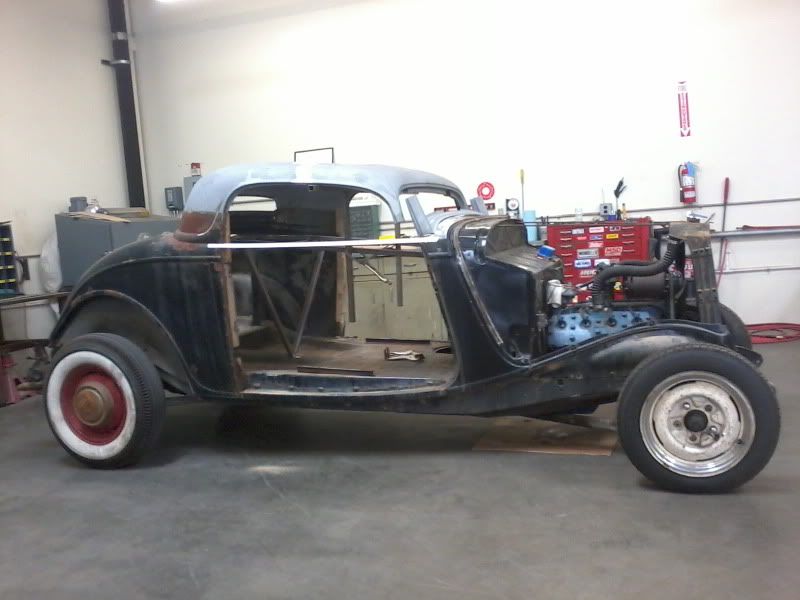
Chop done, roof re-attached, front doesn't line up. The entire lower half of the a pillars have actually been cut out of the cowl section, allowing them to be leant back
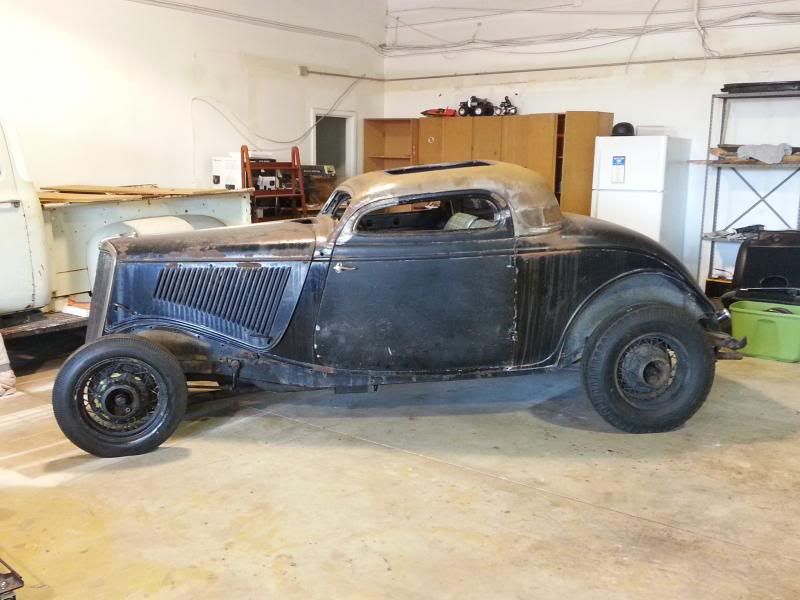
All done

Stock height by comparison
Because in the early days many people would drive their "race car" or "lakes car" on the street chopped coupes were a common sight. So much so that when people were building street cars they'd still chop them to get the look of a hot rod.
Racers would also reduce the frontal area of the grille by making a smaller nose, often called a "track nose" they were typically more aerodynamic.
Both of which lead us nicely to the Pierson bothers coupe

This car is a cornerstone of hot rodding. It still exists today, I think living for most of its time in the Petersen Museum in Los Angeles.
The Pierson brothers built it as a race car, its severe chop providing inspiration for thousands of hot rods. Powered by a flathead engine built by Edlebrock engine supermo Bobby Meeks it went 150mph at El Mirage in the early 50s
You can read more about the Pierson brothers here: http://www.streetrodderweb.com/milestones/0106sr_p...
Soon some started paying more attention to the styling of their cars, one inhabitant of California who was doing this was Harry Westergard. He worked out of his home in Sacramento, modifying the appearance of cars, many people would visit his shop and see what he was doing, two of these people were Sam and George Barris.
Westergard sparked off a whole style but probably never saw the recognition, he died in a street racing accident at the age of 40 in 1956. He was the part of the customising scene.


A Harry Westergard custom, originally a 1940 Mercury

A stock '40 Mercury
Another customiser was George Duval, he worked for a chrome plating company. Often car owners wanted to improve the looks of their cars, to try and make them look for like the luxurious Cadillacs. Amongst other things Duvall developed a replacement windshield, with a graceful swept back design and V shaped posts it would totally transform a coupe with a much more graceful look.

A duvall windshield on a '34 roadster
As the 50's progressed cars got more outlandish - Soon, the overhead valve engines were commonplace in contemporary cars, offering much more power than flatheads and straight sixes, engine swaps became very common. We'll cover it in more detail, but when the small block chevy was released in 1955 it fast became a favourite, with numerous cars sporting the engine by the end of that year.
Style wise the cars became more outlandish too - hot rodders started painting them brighter colours, instead of the dark blues, browns and (of course) black they left the factory with they were repainted lighter and brighter colours, Scallops and flame paint jobs started to appear. I think flames originate from pre WW2 but were not common back then, the 50s is when many started to take more of an interest in to the appearance of their cars. Upholstery was another area that saw attention.

Scallops on a 5 window model A coupe, note the '32 grille
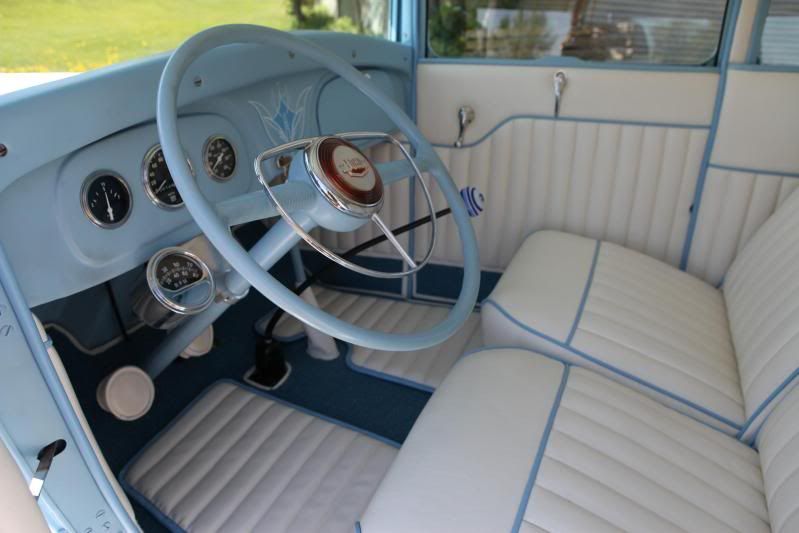
Tuck and roll upholstery, so called because the pleat would be stitched, then folded over and stitched on the underside, resulting in the original stitching being hidden from the top
Next time we'll visit the 60s for gassers, kustoms, show cars and whatever else randomly comes to mind.
Just one note, if you're at a loose end this weekend and fancy checking out some hot rods, drag cars and a wee bit of racing the NSRA is hosting the Nostalgia Nationals at Shakespeare's County Raceway this weekend, more information here: http://www.nsra.org.uk/nsra-nostalgia-nationals/
The weather looks tip top so I imagine it will be pretty busy.
If thats a little short notice, free up your diaries for 1st-3rd August for the NSRA Supernationals. Just about the biggest show in the UK and (imho) the best in terms of turnout and variety. It takes place at Old Warden in Biggleswade, a quick shufty up the A1M from Hitchin and Luton. You can visit all weekend or just for the day on the Sunday.
Do post updates of the build, it'll give us all some insight to an early coupe.
I did write out a post last night showing the different Fords from the 30s, but its kind of pointless really, all you need to know is the year.
To encourage owners to change their car often manufacturers changed the cars every year, this still goes on to this day in the American market.
So, you can identify a car by its year, '33 Ford Coupe for example. Due to their popularity "Ford" is often dropped, so if someone says they have a '36 Sedan they mean a Ford. If they have any other make it'll be specified.
One thing to watch for with '38-40 Fords is that they had two models, Standard and Deluxe. The models weren't new, but in '38 they actually changed the sheetmetal around the grille area. The Deluxe became the next years Standard model sheetmetal.
All manufacturers in the 30s stuck to these basic body styles:
Roadster - convertible roof, windshield is usually bolted on
3 Window Coupe - 2 door, hardtop. 3 Window refers to the number of windows (excluding the windshield)
5 Window Coupe - 2 door, hardtop. Again 5 Window refers to the number of back and side windows.
Sedan - 2 door, hardtop. Has a rear seat and little or no boot space. There are variations, you'll hear "humpback" and "slantback" - they are pretty descriptive terms.
The humpbacks have a bigger trunk (or boot as we'd call it) that stick out in to the side profile of the car.
4 door, sometimes nicknamed "moredoor". Basically a sedan but with 4 doors.
Cabriolet - A coupe with a convertible roof, windshield is part of the body and it'll have roll up windows (unlike a roadster).
Phaeton - A four door sedan with a convertible top, no side windows (at all).
'32 Sedan with a small block chevrolet
Not all manufacturers made all styles, but you get the idea.
Some manufacturers (Ford specifically) did make both 3 window and 5 window coupes, why ? I'm not really sure. The 3 window was more considered "sporty" and is probably a bit more desirable now. 5 windows had a little more space inside.
If you google the terms (e.g. "35 3 window coupe") you'll find countless pictures. Try it with other manufacturers too (chevrolet, pontiac, packard etc).
Back to the '32 for a moment.. as I said, considered by many to be the definitive hot rod. The car was very popular at the time, it was the first year for Ford's flathead V8 engine, released as a 3.6 litre, 65 horsepower engine it survived until 1953 in various forms when it was replaced by the Y-block overhead valve engine.
In 1932 V8 engines were nothing new, Cadillac had been making them since the mid teens but this was the first time that a V8 had been made available to the working class.
Hot rodders, racers (at the lakes or on the track) loved them, as did the bootleggers who'd strengthen the suspension and create hidey holes for their jars of moonshine and then use the flathead power to outrun the cops in order to deliver their goods to speakeasys.
Deuce is a term used for '32s as well (cos of the 2 in the year). Hence the Beach Boys "Little Deuce Coupe", the song is all about a hot rod '32 and racing.. the engine is stroked & bored, both referring to increasing the displacement of the engine, 4 on the floor means its got a manual 4 speed transmission (US term is stick shift).. http://youtu.be/ZXFFLuoaMzM
Henry Ford (like everything) oversaw the development of the flathead. There are books on the man and the story of his company but in short at best he was awkward to work for, at worst he was an anarchist. He had rival development teams working on the V8 engine idea. He told one that the engine shouldn't have a water pump, another that it shouldn't have an oil pump. The reasoning was that these were complicated/expensive things to manufacture, he wanted something cheap and simple to make.
He eventually rescinded on both of these points when engineers proved the engine would simply not be reliable without them.
The flathead was a monoblock design, the valves recessed into the block itself, the heads were just a flat block of cast iron with a small recess for the valves (hence the engine name). All this meant that virtually all the machining was in the block itself. Much simpler than engineering a conventional cylinder head.

Early flathead Ford engine and transmission
By comparison Chevrolet had moved to straight six cylinder engines in 1929 and didn't produce a V8 until the ubiquitous small block chevy was released in 1955.
One of the reasons you'll hear quoted for the pre-49 cut off is because in '49 Ford released an all new car that was quite a departure, it didn't have bolted on fenders, the body was one piece, much like cars now.
Soon, the term "shoebox" was coined, the term really applies to the 49-52 Fords but some use it generically for all early 50s cars.

'49 Ford 'shoebox'
So with the influence from drag, track and dry lake racing in terms of engine power and speed these things also influenced hot rod styling. Pretty early on racers figured out junking the bumpers, fenders (wheel arches) and running boards gave both a weight and aerodynamic advantage. The next thing was the big flat windshields, obviously not good for aerodynamics racers soon started chopping their cars. To chop a car you simply cut the roof off, remove some of the A/B/C pillars and weld the roof back on again.
Easy, right ?
Well, on early cars where everything is vertical, yes its not too difficult.
But soon the bodies had sloped windshields and more graceful lines at the back of the roof section. This makes a chop much harder, because when you put the roof back on the two parts don't line up. the common way to resolve this is by cutting the roof in half, then the front can be married up with the A pillar and the rear section with the back, then you need to fill in the gap between the two pieces.
The alternative is to lay the a pillar back so it matches the roof. Thats how this '34 has been chopped. This gets complicated because of the number of curves and radii that get changed. The other thing with this method is you typically end up with a wedge shape, which some like..

Chop done, roof re-attached, front doesn't line up. The entire lower half of the a pillars have actually been cut out of the cowl section, allowing them to be leant back

All done

Stock height by comparison
Because in the early days many people would drive their "race car" or "lakes car" on the street chopped coupes were a common sight. So much so that when people were building street cars they'd still chop them to get the look of a hot rod.
Racers would also reduce the frontal area of the grille by making a smaller nose, often called a "track nose" they were typically more aerodynamic.
Both of which lead us nicely to the Pierson bothers coupe

This car is a cornerstone of hot rodding. It still exists today, I think living for most of its time in the Petersen Museum in Los Angeles.
The Pierson brothers built it as a race car, its severe chop providing inspiration for thousands of hot rods. Powered by a flathead engine built by Edlebrock engine supermo Bobby Meeks it went 150mph at El Mirage in the early 50s
You can read more about the Pierson brothers here: http://www.streetrodderweb.com/milestones/0106sr_p...
Soon some started paying more attention to the styling of their cars, one inhabitant of California who was doing this was Harry Westergard. He worked out of his home in Sacramento, modifying the appearance of cars, many people would visit his shop and see what he was doing, two of these people were Sam and George Barris.
Westergard sparked off a whole style but probably never saw the recognition, he died in a street racing accident at the age of 40 in 1956. He was the part of the customising scene.


A Harry Westergard custom, originally a 1940 Mercury

A stock '40 Mercury
Another customiser was George Duval, he worked for a chrome plating company. Often car owners wanted to improve the looks of their cars, to try and make them look for like the luxurious Cadillacs. Amongst other things Duvall developed a replacement windshield, with a graceful swept back design and V shaped posts it would totally transform a coupe with a much more graceful look.

A duvall windshield on a '34 roadster
As the 50's progressed cars got more outlandish - Soon, the overhead valve engines were commonplace in contemporary cars, offering much more power than flatheads and straight sixes, engine swaps became very common. We'll cover it in more detail, but when the small block chevy was released in 1955 it fast became a favourite, with numerous cars sporting the engine by the end of that year.
Style wise the cars became more outlandish too - hot rodders started painting them brighter colours, instead of the dark blues, browns and (of course) black they left the factory with they were repainted lighter and brighter colours, Scallops and flame paint jobs started to appear. I think flames originate from pre WW2 but were not common back then, the 50s is when many started to take more of an interest in to the appearance of their cars. Upholstery was another area that saw attention.

Scallops on a 5 window model A coupe, note the '32 grille

Tuck and roll upholstery, so called because the pleat would be stitched, then folded over and stitched on the underside, resulting in the original stitching being hidden from the top
Next time we'll visit the 60s for gassers, kustoms, show cars and whatever else randomly comes to mind.
Just one note, if you're at a loose end this weekend and fancy checking out some hot rods, drag cars and a wee bit of racing the NSRA is hosting the Nostalgia Nationals at Shakespeare's County Raceway this weekend, more information here: http://www.nsra.org.uk/nsra-nostalgia-nationals/
The weather looks tip top so I imagine it will be pretty busy.
If thats a little short notice, free up your diaries for 1st-3rd August for the NSRA Supernationals. Just about the biggest show in the UK and (imho) the best in terms of turnout and variety. It takes place at Old Warden in Biggleswade, a quick shufty up the A1M from Hitchin and Luton. You can visit all weekend or just for the day on the Sunday.
Great to see some posts here, do carry on !
Nick's flickr above is well worth a look, he does some excellent work..
Ok so where were we ?
Late 50s / early 60s... So more and more attention was being paid to paintwork, scallops, flames, pinstriping etc.
Pin striping outdates hot rods by a long, long way - I don't really know why it was picked up by hot rodders, however it soon became a good way to make your car individual - this continues to this day

Pinstriped '32 grille shell

Pinstriped decklid
If you ever get the chance to watch a pinstriper at work do so, its infuriatingly impressive, mostly done freehand and the control the striper has on the brush to keep the line width even in the curves its one of those things that looks deceptively easy.
During the 50s the car show scene took off, the wild customs that the likes of Westergard and Barris were on the show floor alongside hot rods from speed shops and home builders for all to see and provide inspiration.
Towards the end of the 50s some people had the idea of putting small bits of metal in paint, the idea being it would sparkle even more than the metallic paints the manufacturers were using on new cars. Problem was, it was hard to get a uniform finish, the metal bits would clog the gun. In 1960 a custom painter called Dean Jeffries managed it, he figured out by using higher pressure (and presumably a wider tip) the gun didn't clog.
Jeffries was friends with another guy called Kenneth Howard, better known to you and I as Von Dutch. Howard had taught Jeffries how to pinstripe and they both worked on entire paintjobs as well as pinstriping, flames and the like.

Kenneth 'Von Dutch' Howard pinstriping a Barris custom
Howard had a trademark "flying eyeball", some say that it was Jeffries that came up with the design, but let Howard use it, either way its virtually a signature for "Von Dutch". If you recall a few years ago Von Dutch became the cool thing for teenage kids to wear - caps, jumpers etc. Not really Howard's style the big commercial thing, but all his artwork and rights had been sold by his family - someone made a whole bunch of money out of people who have no idea who he was. Life is odd sometimes.
Another painter around this time was Ed Roth, nicknamed 'Big Daddy' he had big ideas and was at the forefront of outlandish paint, imagine this turning up in 1959!

Ed Roth's Outlaw T Bucket
Through the 60s Roth built ever more outlandish show cars, they weren't cars so much, more a canvas for artwork. Some of the cars didn't even run. Custom became Kustom and soon evolved past cars in to an entire sub culture - art, clothing, tattoos and music. The 'Kustom Kulture' is still alive today.

Ed Roth's Orbitron, 1964

Beatnik Bandit, 1961

Ed Roth's Rat Fink
Back to the (slightly) more conventional custom scene the new cars of the 50s were providing huge amounts of inspiration - two brothers Sam and George Barris along with others like Gene Winfield and Bill Hines were taking new/nearly new cars and modifying their looks, if hot rods were all about power, speed and the quarter mile customs were about looking elegant, suave and, well, just damm cool. Top quality paint and chrome is the order of the day for a kustom. The grille is often fabricated from scratch or a modified version of a grille from another car, side trim is also either taken from another car or made.
One of the watershed cars was the Hirohata Mercury. Built by Barris for owner Bob Hirohata it is still considered one of the best Kustom cars

Period picture of the Hirohata Mercury
The '49 and on Mercurys were very popular, to the extent that nowadays an unchopped one is a fairly rare thing. If we thought a chop on a late 30s coupe was tricky this is a whole different ballgame. This video shows a chop being made, its pretty obvious to see how everything is horribly misaligned http://youtu.be/S9qMJoqq590
Kustoms are often called leadsleds, this is because after so much metalwork lots of lead would be used to finish the body (filler hadn't been invented, lead still is regarded by many as the "proper" way to finish a car). Again, its another skill that looks easy but is far harder than it looks.
Bill Hines was born in Detroit, he was soon modifying cars and ended up with the nickname the "leadslinger" as he was a dab hand at it. Hines is rarely seen without a cigar in his mouth, despite that he celebrated his 92nd birthday in March. The commentary (by George Barris nonetheless) could be better but its a good leading demo : http://youtu.be/jQ_85fp1avs keep in mind he's in his mid 80s in the video.
Another painter was Larry Watson, he led the way with eyecatching paintjobs, using metallics, metalflake and effects like fades and lace (literally take a bit of net curtain, lay it over the car and spray over it!) he usually used several colours and followed shapes mimicking the trim of the car. He painted many cars built by the top kustom builders.

The final incarnation of Grapevine
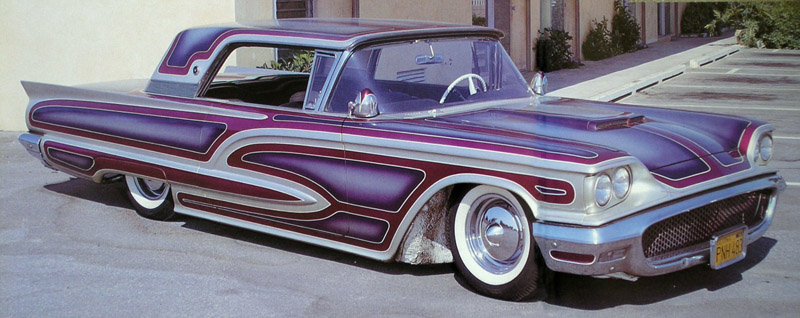
Watson's thunderbird
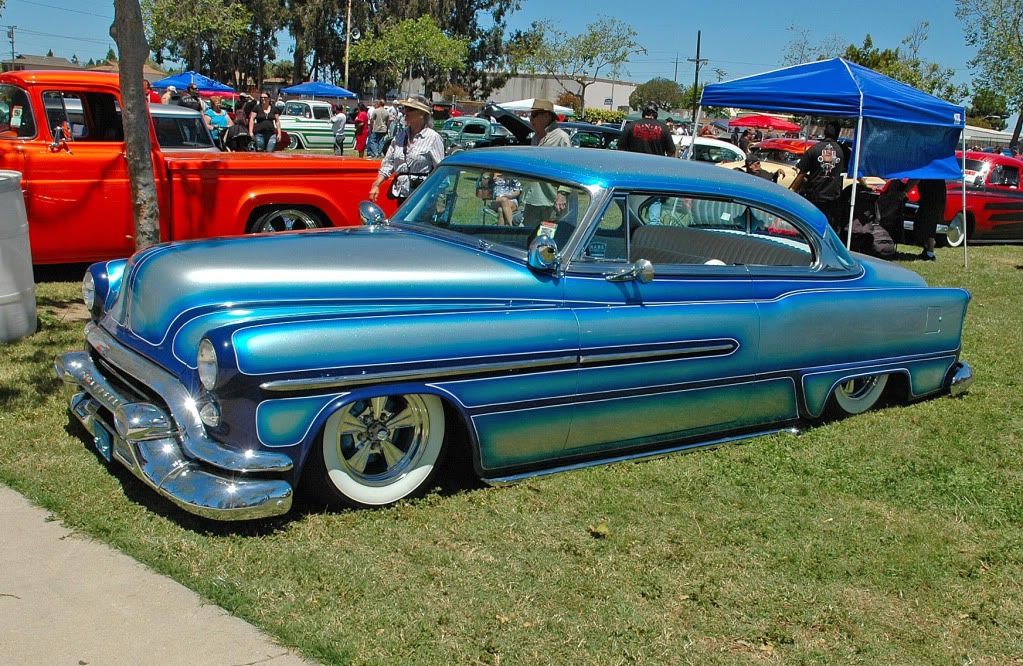
Watson inspired paintjob
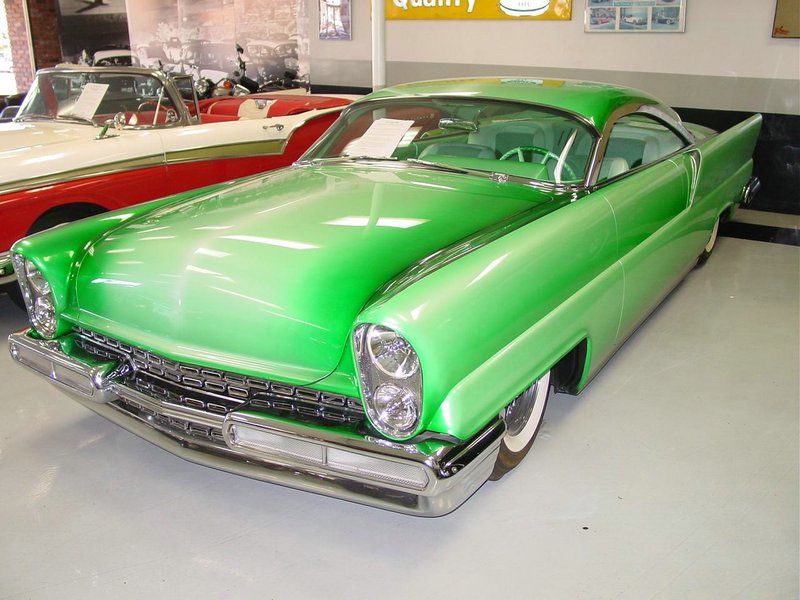
A fade paint job, probably a John D'Augustino car

Lace paint panel on a roof
Many of the techniques and styles that Watson used are still alive today in the lowrider scene (we'll get to that at some point)
Just link back to racing - by the 60s drag racing had become a sport. The NHRA was set up by Wally Parks, then editor of Hot Rod. CJ 'Pappy' Hart realised that this hobby could become something more serious - he built and owned the legendary Santa Ana strip which opened in 1950. He charged spectators to come and watch, but offered prize money to racers. He'd begun the process of drag racing becoming a professional sport. He later ran the Lions Strip which, along with Santa Ana is one of the most fondly remembered tracks. Fantastic story on Lions here http://www.hotrod.com/whereitbegan/hrdp_0273_lions...
By the 60s some had figured out that if they could get the weight to shift to the rear axle on launch it would help with traction. The gasser was born. Often the wheelbase was shortened too. Gassers were very popular and many still love the cars today and even build road cars in the same style. The Willys-Overland pre war cars were basic motoring, no frills but very cheap (think Kia maybe 15-20 years ago). As WW2 started the American military put out a tender for a general purpose all terrain vehicle, Wilys came up with the Jeep - the name being a bastardised version of GP (general purpose). The iconic WW2 jeep was born and the Jeep company (that still makes cars today) was founded.
The pre war cars were unloved and very cheap - perfect then for pulling apart and making a race car from.
There is a huge, huge amount of history around early drag racing in the US. The best place to learn more about gasser racings is www.gassermadness.us, you can also look around www.wediditforlove.com

John Mazmanian's Willys Gasser
The other side of drag racing had evolved from cars like this:

Re-creation of Don Garlits' firt dragster, circa 1955
To what we call a FED, front engined dragster. By the 60s they were running nitromethane on these long slender chassis. The driver literally sat around the 3rd member int he rear axle, if anything was to go wrong the drivers third member was perilously close !
These cars are just beautiful, amazing things. So many names to mention - Garlits, Prudhomme, Kalitta, Donovan.. the list is endless.

Note that the same attention to detail in the appearance of the car is similar to the hot rods of the time, the racers wanted to go (seriously) fast and look good. More info on www.wediditforlove.com, www.cacklefest.com.
Drag racers, just like hot rodders are very proud of their history and in recent years there has been much interest in the FED dragsters, with numerous barn finds, restorations and new cars being built. For about 20 years the NHRA have hosted a big event called the California Hot Rod Reunion where all types of drag cars from the 60s & 70s come out to play in Bakersfield. Its definitely on the bucket list! Look on youtube for videos.
I see Boyd Coddington has popped up, he died in 2008 but the shows are still being repeated. We'll get to him and "his" era but first I need a bit of help, I know very little about the scene in the 70s. Whilst drag racing moved away from the gassers and FEDs and to the funny cars and there was a bit of a downturn in hot rodding because of the muscle cars and oil crisis, it was also the decade that hot rodding really took on in the UK. I was wondering if Streetrodder could fill us in with what he knows/can remember ??
This post was put together from various sources, one in particular that has been useful is www.kustomrama.com (especially for pictures). Another good site is Rik Hovings Kustoms http://www.rikhovingkustoms.com/RHK1/Custom_Car_Ph...
If you want to read more about kustom kulture try www.ratfink.com
Going forwards I can write a piece on the 80s to current day and pull in Boyd, Foose and various others and probably a little bit about UK rodding/drag racing. Anything else people want to know about ?
Nick's flickr above is well worth a look, he does some excellent work..
Ok so where were we ?
Late 50s / early 60s... So more and more attention was being paid to paintwork, scallops, flames, pinstriping etc.
Pin striping outdates hot rods by a long, long way - I don't really know why it was picked up by hot rodders, however it soon became a good way to make your car individual - this continues to this day

Pinstriped '32 grille shell

Pinstriped decklid
If you ever get the chance to watch a pinstriper at work do so, its infuriatingly impressive, mostly done freehand and the control the striper has on the brush to keep the line width even in the curves its one of those things that looks deceptively easy.
During the 50s the car show scene took off, the wild customs that the likes of Westergard and Barris were on the show floor alongside hot rods from speed shops and home builders for all to see and provide inspiration.
Towards the end of the 50s some people had the idea of putting small bits of metal in paint, the idea being it would sparkle even more than the metallic paints the manufacturers were using on new cars. Problem was, it was hard to get a uniform finish, the metal bits would clog the gun. In 1960 a custom painter called Dean Jeffries managed it, he figured out by using higher pressure (and presumably a wider tip) the gun didn't clog.
Jeffries was friends with another guy called Kenneth Howard, better known to you and I as Von Dutch. Howard had taught Jeffries how to pinstripe and they both worked on entire paintjobs as well as pinstriping, flames and the like.

Kenneth 'Von Dutch' Howard pinstriping a Barris custom
Howard had a trademark "flying eyeball", some say that it was Jeffries that came up with the design, but let Howard use it, either way its virtually a signature for "Von Dutch". If you recall a few years ago Von Dutch became the cool thing for teenage kids to wear - caps, jumpers etc. Not really Howard's style the big commercial thing, but all his artwork and rights had been sold by his family - someone made a whole bunch of money out of people who have no idea who he was. Life is odd sometimes.
Another painter around this time was Ed Roth, nicknamed 'Big Daddy' he had big ideas and was at the forefront of outlandish paint, imagine this turning up in 1959!

Ed Roth's Outlaw T Bucket
Through the 60s Roth built ever more outlandish show cars, they weren't cars so much, more a canvas for artwork. Some of the cars didn't even run. Custom became Kustom and soon evolved past cars in to an entire sub culture - art, clothing, tattoos and music. The 'Kustom Kulture' is still alive today.

Ed Roth's Orbitron, 1964

Beatnik Bandit, 1961

Ed Roth's Rat Fink
Back to the (slightly) more conventional custom scene the new cars of the 50s were providing huge amounts of inspiration - two brothers Sam and George Barris along with others like Gene Winfield and Bill Hines were taking new/nearly new cars and modifying their looks, if hot rods were all about power, speed and the quarter mile customs were about looking elegant, suave and, well, just damm cool. Top quality paint and chrome is the order of the day for a kustom. The grille is often fabricated from scratch or a modified version of a grille from another car, side trim is also either taken from another car or made.
One of the watershed cars was the Hirohata Mercury. Built by Barris for owner Bob Hirohata it is still considered one of the best Kustom cars

Period picture of the Hirohata Mercury
The '49 and on Mercurys were very popular, to the extent that nowadays an unchopped one is a fairly rare thing. If we thought a chop on a late 30s coupe was tricky this is a whole different ballgame. This video shows a chop being made, its pretty obvious to see how everything is horribly misaligned http://youtu.be/S9qMJoqq590
Kustoms are often called leadsleds, this is because after so much metalwork lots of lead would be used to finish the body (filler hadn't been invented, lead still is regarded by many as the "proper" way to finish a car). Again, its another skill that looks easy but is far harder than it looks.
Bill Hines was born in Detroit, he was soon modifying cars and ended up with the nickname the "leadslinger" as he was a dab hand at it. Hines is rarely seen without a cigar in his mouth, despite that he celebrated his 92nd birthday in March. The commentary (by George Barris nonetheless) could be better but its a good leading demo : http://youtu.be/jQ_85fp1avs keep in mind he's in his mid 80s in the video.
Another painter was Larry Watson, he led the way with eyecatching paintjobs, using metallics, metalflake and effects like fades and lace (literally take a bit of net curtain, lay it over the car and spray over it!) he usually used several colours and followed shapes mimicking the trim of the car. He painted many cars built by the top kustom builders.

The final incarnation of Grapevine

Watson's thunderbird

Watson inspired paintjob

A fade paint job, probably a John D'Augustino car
Lace paint panel on a roof
Many of the techniques and styles that Watson used are still alive today in the lowrider scene (we'll get to that at some point)
Just link back to racing - by the 60s drag racing had become a sport. The NHRA was set up by Wally Parks, then editor of Hot Rod. CJ 'Pappy' Hart realised that this hobby could become something more serious - he built and owned the legendary Santa Ana strip which opened in 1950. He charged spectators to come and watch, but offered prize money to racers. He'd begun the process of drag racing becoming a professional sport. He later ran the Lions Strip which, along with Santa Ana is one of the most fondly remembered tracks. Fantastic story on Lions here http://www.hotrod.com/whereitbegan/hrdp_0273_lions...
By the 60s some had figured out that if they could get the weight to shift to the rear axle on launch it would help with traction. The gasser was born. Often the wheelbase was shortened too. Gassers were very popular and many still love the cars today and even build road cars in the same style. The Willys-Overland pre war cars were basic motoring, no frills but very cheap (think Kia maybe 15-20 years ago). As WW2 started the American military put out a tender for a general purpose all terrain vehicle, Wilys came up with the Jeep - the name being a bastardised version of GP (general purpose). The iconic WW2 jeep was born and the Jeep company (that still makes cars today) was founded.
The pre war cars were unloved and very cheap - perfect then for pulling apart and making a race car from.
There is a huge, huge amount of history around early drag racing in the US. The best place to learn more about gasser racings is www.gassermadness.us, you can also look around www.wediditforlove.com

John Mazmanian's Willys Gasser
The other side of drag racing had evolved from cars like this:

Re-creation of Don Garlits' firt dragster, circa 1955
To what we call a FED, front engined dragster. By the 60s they were running nitromethane on these long slender chassis. The driver literally sat around the 3rd member int he rear axle, if anything was to go wrong the drivers third member was perilously close !
These cars are just beautiful, amazing things. So many names to mention - Garlits, Prudhomme, Kalitta, Donovan.. the list is endless.

Note that the same attention to detail in the appearance of the car is similar to the hot rods of the time, the racers wanted to go (seriously) fast and look good. More info on www.wediditforlove.com, www.cacklefest.com.
Drag racers, just like hot rodders are very proud of their history and in recent years there has been much interest in the FED dragsters, with numerous barn finds, restorations and new cars being built. For about 20 years the NHRA have hosted a big event called the California Hot Rod Reunion where all types of drag cars from the 60s & 70s come out to play in Bakersfield. Its definitely on the bucket list! Look on youtube for videos.
I see Boyd Coddington has popped up, he died in 2008 but the shows are still being repeated. We'll get to him and "his" era but first I need a bit of help, I know very little about the scene in the 70s. Whilst drag racing moved away from the gassers and FEDs and to the funny cars and there was a bit of a downturn in hot rodding because of the muscle cars and oil crisis, it was also the decade that hot rodding really took on in the UK. I was wondering if Streetrodder could fill us in with what he knows/can remember ??
This post was put together from various sources, one in particular that has been useful is www.kustomrama.com (especially for pictures). Another good site is Rik Hovings Kustoms http://www.rikhovingkustoms.com/RHK1/Custom_Car_Ph...
If you want to read more about kustom kulture try www.ratfink.com
Going forwards I can write a piece on the 80s to current day and pull in Boyd, Foose and various others and probably a little bit about UK rodding/drag racing. Anything else people want to know about ?
Edited by Crafty_ on Tuesday 24th June 01:29
Edited by Crafty_ on Tuesday 24th June 01:31
Nick Grant said:
Crafty_ said:
...but first I need a bit of help, I know very little about the scene in the 70s. Whilst drag racing moved away from the gassers and FEDs and to the funny cars and there was a bit of a downturn in hot rodding because of the muscle cars and oil crisis, it was also the decade that hot rodding really took on in the UK. I was wondering if Streetrodder could fill us in with what he knows/can remember ??
I'm a little young but I know plenty of people who were part of this, from what I understand the release of American Graffiti really kickstarted the UK Custom Scene and lead to cruising round London and eventually the Chelsea Cruise. American Graffiti is a "coming of age" movie, written by George Lucas (prior to Star Wars) and produced by Frnacis Ford Coppola (who went on to make the Godfather movies) and starring young actors Ron Howard, Richard Dreyfuss and Harrison Ford it tracks a bunch of recent high school graduates over a single day. It was set in 1962 (hence the byline "Where were you in '62?") its mostly made up of Lucas's memories of growing up in Modesto, California. It was made for a small budget (about $750k) and has apparently earned over $200 million.
For those who were around in the 60s its a great reminder of how life was, for those who are younger its a small peek at the time they call "back in the day".
Not much more to say really - go and watch it! There is a fan site here with all sorts of information at: http://americangraffiti.net/
There was a sequel (More American Graffiti) that continues the story of the group of friends, it doesn't have the same following as the first film but does have some neat drag racing in it, not to mention the smoking hot blonde! I reckon its still worth a look.

Milner (Paul Le Mat) squares up to Bob Falfa (Harrison Ford) in AG
Hot rod films have been around almost as long as the hot rod itself, there was a whole bunch made back in the 50s - Hot Rod Gang (http://youtu.be/zj5dIeA6Xo8), Hot Rod Girl (http://youtu.be/tfr32OkQIFE) to name just two. Check out this page for many more http://www.ahrf.com/category/cool-stuff/hot-rod-mo...
Other hot rod movies ? California Kid (released a few years after American Graffiti) starred a Pete Chapouris built '34 3 window which has virtually cult status.
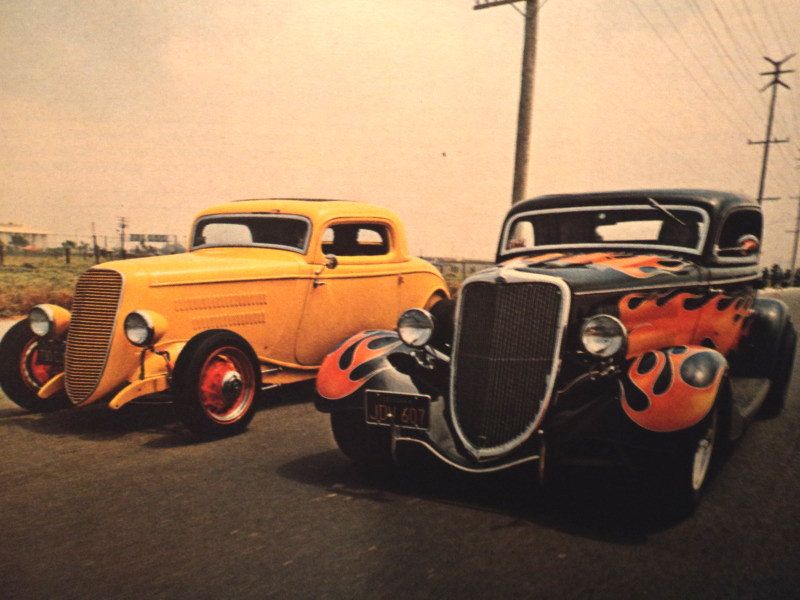
The California Kid (right) with Jim Jacobs '34
The other that immediately springs to mind is 2 lane blacktop, starring Dennis Wilson (The Beach Boys) and musician James Taylor and Laurie Bird as "the girl" its a road movie it starred a '55 Chevy that is driven from town to town, racing for money. Personally I think its a bit of an odd film but I've watched worse..

The two lane blacktop '55
Hotrods influenced music too, during the 60s surf music would often mention hot rods and or drag racing. Of all the surf bands none are more popular than The Beach Boys, songs like Little Deuce Coupe, I Get Around, 409 and Shutdown, the music pretty much sums up life in 60s California - surfing, hot rods and chasing girls.
The Beach Boys were far from being the only group making this sort of music, but were the most commercially successful.
I'm not really sure where the association was made, but there is a strong link between rockabilly and hot rods. Artists like Brian Setzer and Reverend Horton heat are pretty popular.
If you like the gold oldies try listening in to hot rod radio (http://www.hotrodradio.com/), every week or so there is a couple of hours of music put up as a podcast (you can find it on itunes here: https://itunes.apple.com/us/podcast/hot-rod-radio-...
I'm sure the other contributors can add some more information around the music.
As with many hobbies/pastimes before the internet came along magazines were a vital source of information, a kingpin for the hot rod magazines was Robert E Petersen. He built a publishing house that specialised in automotive titles - Hot Rod, Car Craft, Rod & Custom, Motor Trend (and later Streetrodder magazine). In the early 90s he purchased an old department store that sits on Wilshire Boulevard in Los Angeles to house an automobile museum. If you're ever in the area its definately worth a look - http://www.petersen.org/
Hot Rod magazine (started by Petersen) started in 1948 with Wally Parks (NHRA founder) as its editor. It soon became popular as more people got involved in the hobby and drag racing. Its still produced today and focuses on street/strip cars and tech.

The first issue of hot rod magazine
Nowadays, the internet makes the hot rodding world a smaller place - people can connect with other rodders all over the world, we can get near real time pictures and info from shows. For the strictly traditional side there is no great site that Ryan Cochran's Jalopy Journal (http://www.jalopyjournal.com/), the site's forum called the Hokey Ass Message Board (or HAMB) for short is pretty much the biggest hot rod message board in the world. In particular the history threads are, I think really valuable, often with personal photo collections and first hand accounts.
There are scores of other sites and forums, some specialise (e.g. particular years/makes), some are news & event sites (e.g. http://www.rodauthority.com/www.hotrodhotline.com (as already mentioned by someone)) and so on. Again maybe other contributors can add their favourite haunts.
I need to do some posts on the current (US) shows and associations and try and cover the scene in the UK - events, clubs, websites etc.
We also need to do 80s to today at some point.
Cotty said:
Isn't the '55 Chevy in American Graffiti and Two Lane Blacktop the same car?
Yes, there were two '55s used in AG, the main car was re-used in 2 Lane Blacktop and is a sedan (has a b-pillar). The other AG car was a hardtop that they stuck a bit of 4x2" in to imitate the pillar. In American Graffiti you don't see the hood open, just as well, the engine wasn't available in '62.So I did a bit of thinking and a bit of reading around the 70s.
Obviously the muscle car thing had taken off in the latter half of the 60s, why screw around with one of those old rusty cars when you could go buy a fast car off the showroom floor ? Naturally many of the cars quickly found their way to the drag strip.
The cars were a progression from the old gassers, the nose high stance started to disappear, but the altered wheelbase stayed.. the cars were soon called "funny cars because, well, they looked kinda funny compared to the stock car..
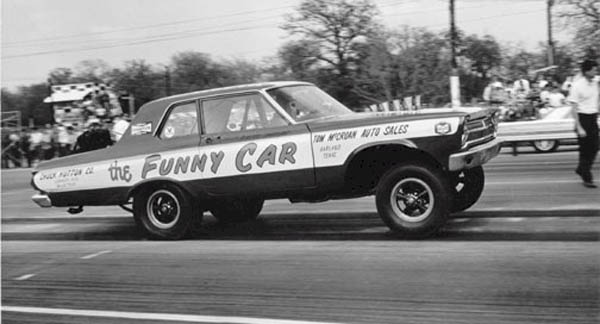
60s funny car
These cars were big and heavy, soon the bodyshells were stripped of everything, from there it wasn't a huge leap to produce a one piece body in fibreglass that would fit over a full tube chassis, known as floppers, because the body flopped over the chassis. The bodies ended up being stretched, sectioned and generally cut about to suit the wheelbase of the chassis and to make them more aerodynamic.

A Mercury Cougar flopper
The funny cars were hugely popular in the 70s. The NHRA had a number of stock classes, the ultimate being pro-stock, it required a stock body & chassis and a gas (petrol) engine. So in many respects the close link between hot rods and drag racing became a bit tenuous.
Drag racing became more professional - more and more companies were using it as an advertising medium, which meant more and more money came to the sport.
Meantime, on the street, the number of hot rods was dwindling, customs and kustoms even more so. Magazines had moved to cover drag racing and drag cars.
The writers on Rod & Custom magazine organised a show in 1970, called The Street Rod Nationals hosted in Peoria, Illinois there were pleasantly surprised when 600 cars turned up. Half the idea of the show was to get lots of cars photographed for features for the magazine - it was a cheap way doing doing so, rather than travelling all over the country to do features on cars.

The first Street Rod Nationals, 1970
Leading up to the show hot rodders had been concerned about a number of issues - smog (emissions) and safety legislation were becoming concerning, hot ordders sometimes found it different to get insurance cover. What was needed was a national organisation to promote the hobby and look after some of the issues that hot rodders faced. As the street rod nationals was a meeting of like minded souls, they resolved to establish the National Street Rod Association (NSRA). The NSRA took over the running of the Street Rod Nationals and has held the show every year since, the show is currently held in early August in Louisville and attracts over 10,000 cars. Through the year they run events all over the USA.

Aerial image of the Street Rod Nationals
Nevertheless, Rod and Custom magazine closed its doors in 1971, a few issues were produced in 1972 but it was then merged with Hot Rod magazine. R&C wouldn't return in its own right until 1988.
As pointed out by Nick the American Graffiti movie rekindled some interest in hot rods and customs, magazines like Hot Rod and Street Rodder saw an upturn in sales.
Companies started appearing, selling components for hot rods - Pete & Jakes, Superbell Axles and Jerry Kugel were making parts, most would also build you an entire car. Fibreglass bodies started appearing, it was easier than finding an old wreck and fixing the rust (especially given the lack of patch panels).
Andy Brizio, a native of San Francisco figured that rather than just selling odd components it'd be better to put together an entire set that would make a while car, his 'Instant T' was born. Brizio is known as 'the rodfather' for his contributions to the hobby that inspired so many to build a car. His son, Roy followed family tradition and is well known for building high quality hot rods.
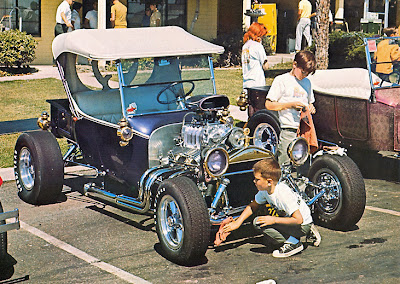
Andy Brizio's Instant T
Customs made a bit of a comeback too, the 50s cars were cheap by this time and the kustomers of the 50s like the Barris's, Gene Winfield and the Ayala bothers were still around to help make your car individual.
With the hobby healthy again the scene was set for a big upturn in the 80s that involve pro street, Boyd, billet and pastel paint..
Obviously the muscle car thing had taken off in the latter half of the 60s, why screw around with one of those old rusty cars when you could go buy a fast car off the showroom floor ? Naturally many of the cars quickly found their way to the drag strip.
The cars were a progression from the old gassers, the nose high stance started to disappear, but the altered wheelbase stayed.. the cars were soon called "funny cars because, well, they looked kinda funny compared to the stock car..

60s funny car
These cars were big and heavy, soon the bodyshells were stripped of everything, from there it wasn't a huge leap to produce a one piece body in fibreglass that would fit over a full tube chassis, known as floppers, because the body flopped over the chassis. The bodies ended up being stretched, sectioned and generally cut about to suit the wheelbase of the chassis and to make them more aerodynamic.

A Mercury Cougar flopper
The funny cars were hugely popular in the 70s. The NHRA had a number of stock classes, the ultimate being pro-stock, it required a stock body & chassis and a gas (petrol) engine. So in many respects the close link between hot rods and drag racing became a bit tenuous.
Drag racing became more professional - more and more companies were using it as an advertising medium, which meant more and more money came to the sport.
Meantime, on the street, the number of hot rods was dwindling, customs and kustoms even more so. Magazines had moved to cover drag racing and drag cars.
The writers on Rod & Custom magazine organised a show in 1970, called The Street Rod Nationals hosted in Peoria, Illinois there were pleasantly surprised when 600 cars turned up. Half the idea of the show was to get lots of cars photographed for features for the magazine - it was a cheap way doing doing so, rather than travelling all over the country to do features on cars.

The first Street Rod Nationals, 1970
Leading up to the show hot rodders had been concerned about a number of issues - smog (emissions) and safety legislation were becoming concerning, hot ordders sometimes found it different to get insurance cover. What was needed was a national organisation to promote the hobby and look after some of the issues that hot rodders faced. As the street rod nationals was a meeting of like minded souls, they resolved to establish the National Street Rod Association (NSRA). The NSRA took over the running of the Street Rod Nationals and has held the show every year since, the show is currently held in early August in Louisville and attracts over 10,000 cars. Through the year they run events all over the USA.

Aerial image of the Street Rod Nationals
Nevertheless, Rod and Custom magazine closed its doors in 1971, a few issues were produced in 1972 but it was then merged with Hot Rod magazine. R&C wouldn't return in its own right until 1988.
As pointed out by Nick the American Graffiti movie rekindled some interest in hot rods and customs, magazines like Hot Rod and Street Rodder saw an upturn in sales.
Companies started appearing, selling components for hot rods - Pete & Jakes, Superbell Axles and Jerry Kugel were making parts, most would also build you an entire car. Fibreglass bodies started appearing, it was easier than finding an old wreck and fixing the rust (especially given the lack of patch panels).
Andy Brizio, a native of San Francisco figured that rather than just selling odd components it'd be better to put together an entire set that would make a while car, his 'Instant T' was born. Brizio is known as 'the rodfather' for his contributions to the hobby that inspired so many to build a car. His son, Roy followed family tradition and is well known for building high quality hot rods.

Andy Brizio's Instant T
Customs made a bit of a comeback too, the 50s cars were cheap by this time and the kustomers of the 50s like the Barris's, Gene Winfield and the Ayala bothers were still around to help make your car individual.
With the hobby healthy again the scene was set for a big upturn in the 80s that involve pro street, Boyd, billet and pastel paint..
stephen300o said:
Thats '42 or '46 - '47 Ford. The grille has the nickname "jailhouse" because of the grille. The pickups have the same front end.A little bit more on the 70s..
1932, Florida. Donald Garlits is born, known better as Don he started drag racing in the 1950s, campaigning a series of cars he named swamp rat. He was the first man to break 170, 180, 200, 240 and 270mph records.

Don Garlits
In 1970 he was competing at an event at the famous Lions drag strip that was mentioned a page or two ago. The car (Swamp Rat 13) was running an experimental two speed transmission, in the final race it exploded on the start line, large pieces of shrapnel cut through the car's chassis, cutting the car in two. One piece severed part of Garlit's right foot, another piece went in to the crowd and seriously injured a spectator.
Accidents were common, but this was a big one. Many thought Garlits would retire, he had other ideas.
The problem he figured, was having the engine in front of the driver, if it was behind the driver would be much safer.
From what I can gather the idea of a rear engined car wasn't necessarily new, but no-one had dare to try it. Garlits set about building Swamp Rat 14, it worked and drag racing was changed forever.

The infamous Swamp Rat 13 accident

Swamp Rat 14
Garlits is a legend. On a recent work trip to the USA I happened on a few minutes of TV coverage from Bradenton, Florida. A team were trying to make an all electric dragster go 200mph and were testing out the car. In the end it "only" went 184mph, a new record. The driver? non other than Garlits himself, so at the age of 82 he is still breaking records.
If you are ever in Orlando on holiday forget going to see Mickey and take a trip up to Ocala where the Garlits museum is, I promise you its worth the trip.
As the 80s began, on the street the influence of the pro stock drag classes was becoming evident - street machines started appearing, muscle and mid sized cars with built engines and strip chassis sported large rear tyres for grip.

Early pro street Nova
It didn't take long before the style came to the street rods, none more famous than Fat Jack Robinson's '46 Ford. This car was very influential, sadly it no longer exists, after being destroyed in an on track accident.

The fat attack '46 Coupe
Roadgoing street rods started sporting roll cages, spartan aluminium sheet interiors and skinny front wheels that were completely as odds with the wide rears.
Somewhere around this time a machinist at Disneyland quit his job and started building street rods from his home garage, his name was Boyd Coddington. His work caught the idea of a race car and hot rod builder by the name of John Buttera. Both had a similar outlook, to drag these old cars up to date - bumpers were removed, hinges changed to pivot inside the car, anything that looked a bit awkward or disturbed the lines of the car got the chop. As experienced machinists they both fabricated parts from alloys or aluminium, wheels, rear view mirrors, gear shifters, even suspension equipment.

John Como's '29 roadster won the AMBR in 1980, car built by John Buttera

Coddington won AMBR in 1985 with this phaeton, built for Larry Murray
Probably the biggest legacy from this style and era is the billet wheel. Boyd had started making wheels from solid stock, no longer did your car have to have the same cast wheel as everyone else.
Another hugely influential car was the ZZ Top Eliminator coupe. The car was used in several of the band's videos. In case anyone hadn't figured it out yet hot rods were cool again.
The Eliminator coupe, a '33 Ford
Meantime in Northern California a familiar name was back - Roy Brizio, son of Andy open his shop and quickly gained a reputation for high quality work that continues to this day. In 1987 he won AMBR with a V12 Ferrari powered '32 roadster. The car was probably 10 years ahead of its time

James Ells's Ferrari powered '32
Also in the same area, 1987 saw a new national organisation appeared to promote hot rods. Gary Meadors had organised shows before, but now he formed Goodguys Inc. They soon started putting on shows across the country, in response to the NSRA strict pre '49 rule they accepted cars up to '72.
Meador's own '32 Sedan was refreshed by Dick Magoo and passed over to Sam and Chip Foose for bodywork and paint, with this typically 80s graphics and hiboy stance it was enshrined in the goodguys logo

'32 Sedan owned by Gary Meadors
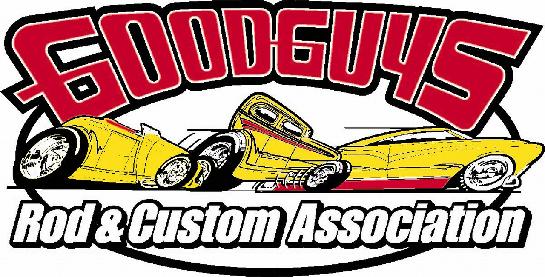
Goodguys logo
Edited by Crafty_ on Sunday 29th June 23:57
Edited by Crafty_ on Sunday 29th June 23:58
Getragdogleg said:
I often wonder who is doing this now, I read about what Isky, Garlits, Barris, Parks, Peterson and all the others were doing back in their day but who are we going to be looking back on from our era, who is doing new and interesting stuff now ?
Lots of people will probably say Kaufmann (from Fast and loud) or any of the other TV stars but are they really in the same league ? Have we had the innovators and are now on the era of refining ?
The TV crowd have a long way to go imho.Lots of people will probably say Kaufmann (from Fast and loud) or any of the other TV stars but are they really in the same league ? Have we had the innovators and are now on the era of refining ?
Edited by Getragdogleg on Tuesday 1st July 08:42
Troy Trepanier - One of the most versatile builders out there. All the way from the Ritzow '32 to the Poteet '69 Cuda Bonnieville car. All of it top notch.
Alan Johnson - The B400 he did a couple of years ago is sublime.
Jesse Greening - Lots of subtle details to his builds, he's still quite young I think - lots more to come
All quite aside from the guys that just get it right all the time - Brizio, Alloway, D’Agostino etc.
There are so many shops turning out decent stuff, we could be here all day pulling names out of a hat.
Turn7 said:
Crafty_ said:
1964, Blackbushe??
Nope, SPR.My first ever visit,and a certain Mr Garlits was there.....
Good to see 'Brizey' posting here, I hope he (and others!) will contribute soon for the british rodding history..
As the 80s progressed into the 90s the hot rod world seemed to see an upturn, No big surprise, muscle cars were just an old car by now and new cars were.. well.. rubbish.
More and more hot rod shops sprang up with enthusiastic amateurs turning professional, also more parts manufacturers and suppliers started to appear. Part suppliers were nothing new of course but now there were so many - suspension parts, electrical wiring kits, engine mounts, steering columns, even air conditioning systems - almost everything you could think of.
Coddington had established Hot Rods by Boyd in Stanton, CA as well as Boyd Wheels, during this time he really was a leading light. During this time a guy called Sam Foose had a shop that built hot rods but also made film props, his son, Chip helped out in the shop from an early age.
Chip had a real talent for drawing and design and went to college to study design. He then worked for a company that did design work for OEM manufacturers, eventually ending up leading the design side. In 1990 Foose had finally graduated and was working part time for Coddington, the job went full time a few years later and Foose ended up president of Hot Rods By Boyd. During this time he designed wheels and cars, including the Boydster cars, a series of custom bodies built exclusively by Boyd. Based on the early ford roadsters but stretched, chopped, tweaked they certainly created a stir, the Boydster II won AMBR in 1996 (AMBR is an award for Americas Most Beautiful Roadster).

Boydster ii

Boydster iii
Foose is the youngest person ever to be inducted in to the hot rod hall of fame at 31 years old.
I don't know exactly what happened, it seems Foose had financial or business interest in the Boyd company. It went bankrupt, Foose and Coddington fell out. It seems there were some sharp practices, Coddington held on to the wheel company and soon set up again in the shop we all saw on TV.
Also in the 90s another 2nd generation car builder was on his way, having built some cars and received accolades from Hot Rod magazine and Goodguys he formed Rad Rides in the mid 90s, his name ? Troy Trepanier.
90s, we're in Tennessee, Bobby Alloway, a general manager at a Ford dealership quits his job and opens up his hot rod shop. Alloway was already no stranger to top level car building, he'd won the 1985 Ridler award with his '33 Ford Victoria. He lost the entire shop to a fire in 1998, but already had a reputation for really, really nice cars. His trademark look is to use a tyre with lots of sidewall in the rear and less so in the front, giving the cars a rake purely from the tyre height differences. I really like his stuff.

Bobby Alloway
The average street rod in the 80s and 90s was all a bit Miami Vice really. Pastel colours, pinstriping gave way to graphics, the dralon buttoned interiors of the 70s had given way to tweed. As with most of the 80s we'd consider it pretty poor taste now!

A typical 80s/90s street rod, ick!
The escalating costs of the top cars and the relative lack of taste of others turned some people off. They liked what they considered hot rods not street rods. They'd build a traditional looking car, steel wheels, maybe even wired wheels with a beam front end, definitely not a small block engine, they tried to use original parts that the street rodders were throwing away and so on. they soon got the name "low buck" cars, because compared to the high costs of a state of the art street rod, they were.. the street rodders got the name "goldchainers" on account of their show of wealth.
As we said goodbye to the 90s street rods started to become more tasteful - like the Miami Vice jeans the pastel colours were gone as were the dodgy graphics. Thanks to people like Alloway cars started getting a good stance - until now street rods hadn't had the nice rake of a hot rod, but it was coming back.
Foose revamped a Boyster for Chuck Svatos, now renamed the 0032 it won AMBR in 2000. Svatos traded the car to Foose for work on a '32 3 window. Foose sold the 0032 to the Petersen museum and used the money to start Foose Design. In 2002 he won the Ridler with Wes Rydell's '35 Chevy 'Grandmaster'.

Wes Rydell's 'Grandmaster'
For what it is I love the car, graceful lines, its a bit like the 30s european cars. Above all else its just so well executed. Every single panel gap is 1/8th of an inch. There is a build gallery here: http://www.garagescene.net/gallery3/index.php/Buil...
Just a year later he was back with Ron Whiteside's Stallion, a '34 3 window. It took the ridler award. Again a tweaked body and just perfect execution of the build.. Foose was the target that everyone had to beat

Ron Whiteside's Stallion
Build pictures here: http://www.wallesdator.com/Foose%20design/Stallion...
2004 Foose sat out the Ridler, the car he was building for Ken Reister wasn't ready. He was back in 2005 with Reister's car and again took the top trophy. Impression is loosely based on a '36 Ford, but was a scratch built body (by Marcel Deley). I've seen this one up close and its just beautiful, the details are so subtle and its proportions are just right. Looking back, the problem is was this still hot rodding ? you could argue that this was bespoke coachbuilding of luxury cars. For everyone else, how can you beat this ? it sort of left everyone with nowhere to go.

Ken Reister's 'Impression'
Build pics here: http://wallesdator.com/Foose%20design/Impression/P...
Back to Troy Trepanier, in the mid/early 90s he had built a '39 Chevy and took it to some of the big shows, one of the guys he met was George Poteet.
Poteet is a car nut, a very rich car nut. He owns Shelby Cobra #1 and a bunch of other exotic race cars. He's also a hot rod nut and is permanently having cars built - at least 2 or 3 a year, every year.
Poteet asked Troy what he was going to do next, Troy said he wanted to do a Plymouth Savoy and already had ideas for the changes. Poteet replied that he'd had one of those years ago and commissioned the car.
Troy had already chatted to Chip months before and whilst they were talking on the phone Chip had scribbled a drawing and faxed it to Troy.
So, here's a 1954 Plymouth:

Here's the car that Troy built, nicknamed Sniper

This car really put Troy on the map, first of all it was a custom - the custom/kustom scene had been quiet for a while, it'd sort have gone out of fashion. Firstly the car was top quality work, but it also had another trick up its sleeve.. that swoopy body was covering a full Dodge Viper drivetrain. Troy had the idea before starting the car, but this was mid 90s, the Viper a supercar - how do you get hold of one without selling the kids ?
Simple, you phone Chrysler and ask for one. Thats exactly what Troy did, a short while later they said "Come up here and bring a trailer". They gave him a development car "Use what you want, just bring the rest back so we can crush it".
Cars for Roger Ritzow (traditional '32 roadster with lots of modern tricks), Glen Grozich ('62 Chevy with 1200hp from its twin turbo engine).

Roger Ritzow's '32 Roadster

Glenn Grozich's '62 Chevy
Then some guy called Ross Myers asks Troy to build him a '36 Ford. Myers had owned the car since he was a teenager. Named First Love the car won the 2007 Ridler award. You'll note that the car although sporting quite a few body mods is very representable of the '36 Ford - quite a change from the Foose car just 2 years before.

Ross Myer's '36 Ford
There are a few build pictures here: http://www.radrides.com/photos/gallery/images?albu...
The entire underside of the car is just amazing, pretty much the entire lot was machined in house, the brakes, the hubs, wishbones, axle casing, you name it.
Some good pics of it here : http://www.pinupsandkustoms.com/blog/rad-rides-by-... Beware - some of the background images on that site are NSFW.
Again its attention to detail and high quality work. Foose crawled all over the car when it was unveiled and proclaimed himself glad that he wasn't competing against it. A year alter I watched Roy Brizio do pretty much the same with Troy.
There is a lot to look at with this car - some cars you take a good look at and you've seen it. This one each time you happened to walk by you noticed something else, a little detail here and there. I could see there was something going on with the wheels, took me a while and a chat with a mate to figure it out - the wheels are different size front to back (not unusual) but they've changed the PCD of the wheel in proportion to its diameter, just another little detail..

Troy & Roy Brizio look over First Love at the 2008 Grand National Roadster show, note the removed shoes in the background
These cars are what I call the ultra street rods at their height, just incredible workmanship and quality. It wasn't to last...
Meantime some of the low buck guys had gone one step further and were building rat rods. This all started as an antithesis to the high buck stuff remember - criticism was given for trailering street rods to shows (which had been going on years), liberal over use of billet (machined aluminium parts) and so on. The irony is that as rat rods got more and more extreme, they were being trailered to shows as they were undriveable, whilst street rods in the 80s and early 90s were a bit tasteless I'd venture that rat rods are no better, but I guess thats subjective.
Basically the rules of rat rod building are : find some rusty car bits, throw them together, cut up anything you can and then look cool.. The more dangerous the better - we're talking no floors, no front brakes, suicide front end setups and so on.
To be fair the "rat rod" name gets thrown around a lot, a rusty truck isn't a rat rod, a flat black roadster or coupe might be "old skool" but it isn't a rat rod.
I don't really have much time for rat rods and the arrogant attitude that some owners have. I'm sure there are some safe, well built cars out there but christ there is lots of dangerous junk too. Asthetically they do little for me:
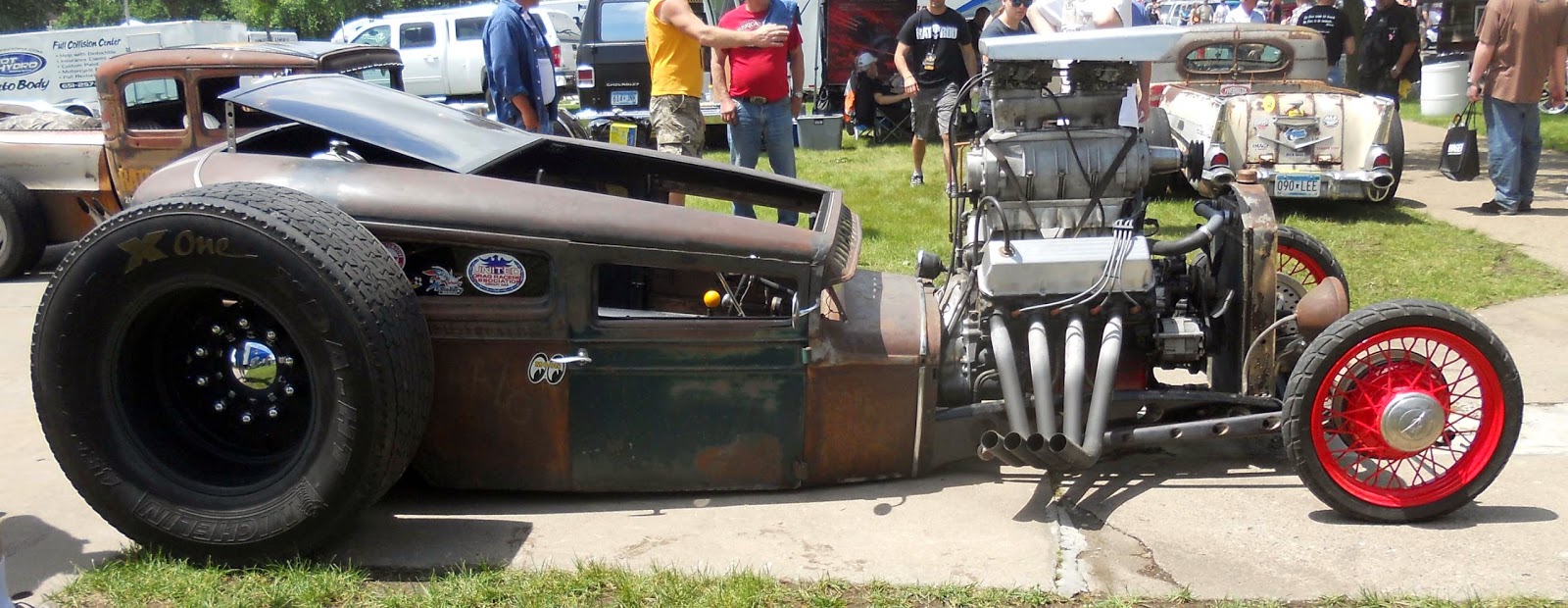


Over the past maybe 10 years things have met in the middle a bit, rat rods seem to be less prevalent, the high end stuff is a bit more subtle and low key, traditional looking cars are popular and pretty much everyone is keeping original trim and detail parts that might have been removed previously. Some of the guys building rat rods have grown up a bit and have stopped doing dumb stuff, even the "old skool" boys have got tired of flat black paint with red wheels...
Apologies for the long post, I wanted to get the timeline stuff finished, if you guys are interested there is stacks more history stuff - people who owned or built cars or made parts, styles, personalities and so on but we can't hope to cover it all so I'm sure bits and pieces will come up as we go.
So, am I talking to myself yet ? Does anyone have any questions or stuff you'd like to know more about ?
Random pictures..

John Mumford's Brizio built '27 T roadster, 2012 AMBR winner
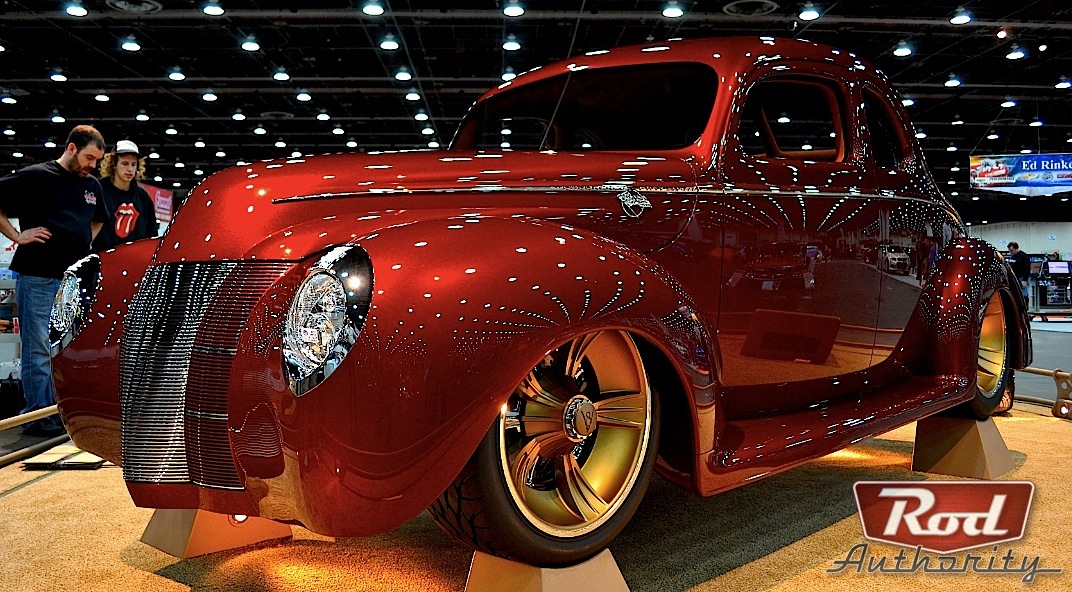
Ron Cizek's Checkered Past '40 Ford. Built by Andy Leach who is an ex- Rad Rides employee. 2013 Ridler winner

Bobby Alloway built '32 Vicky, 2013 Goodguys street rod of the year

60s inspired T bucket

Model A roadster

'32 3 WIndow in build at SoCal Speedshop

'36 Roadster

'64 Falcon
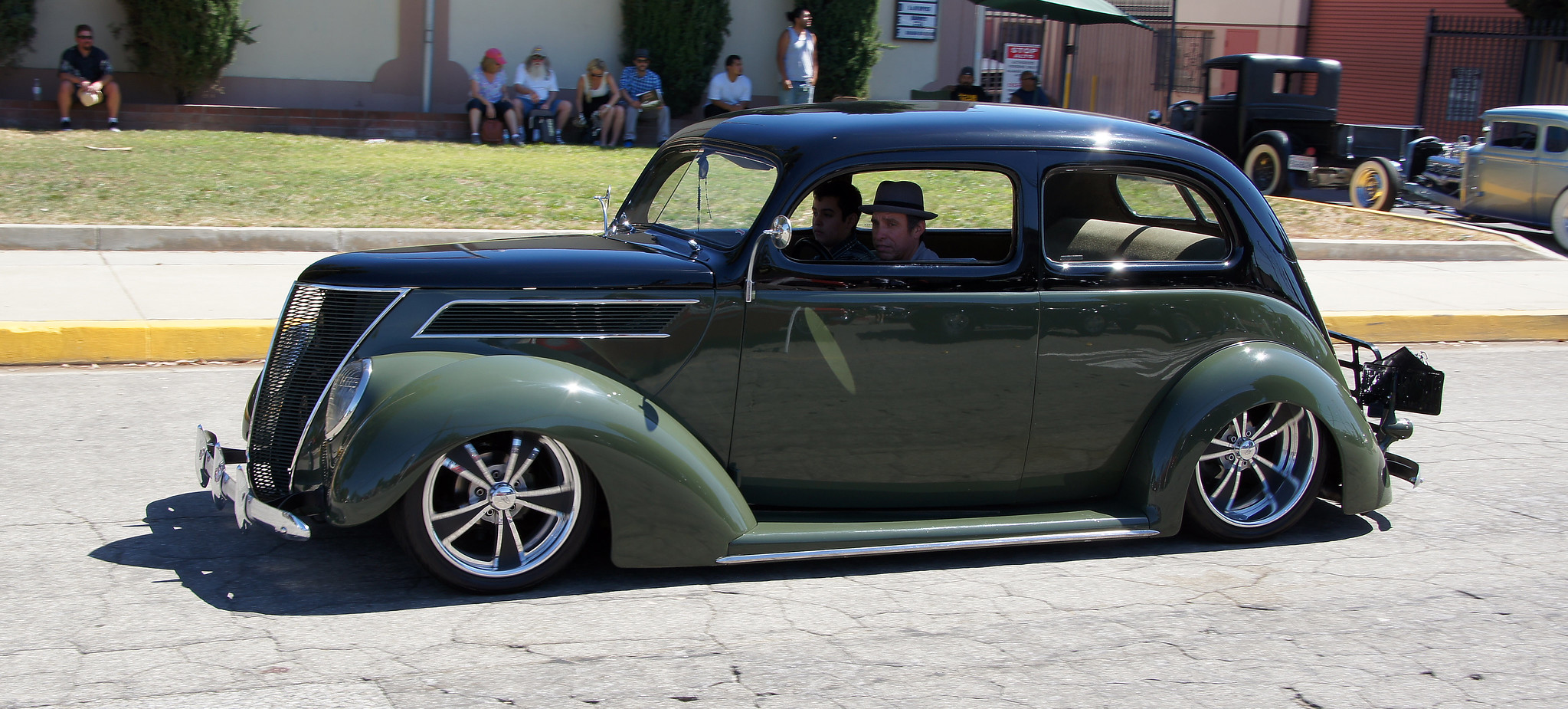
'37 Sedan

'32 3 window
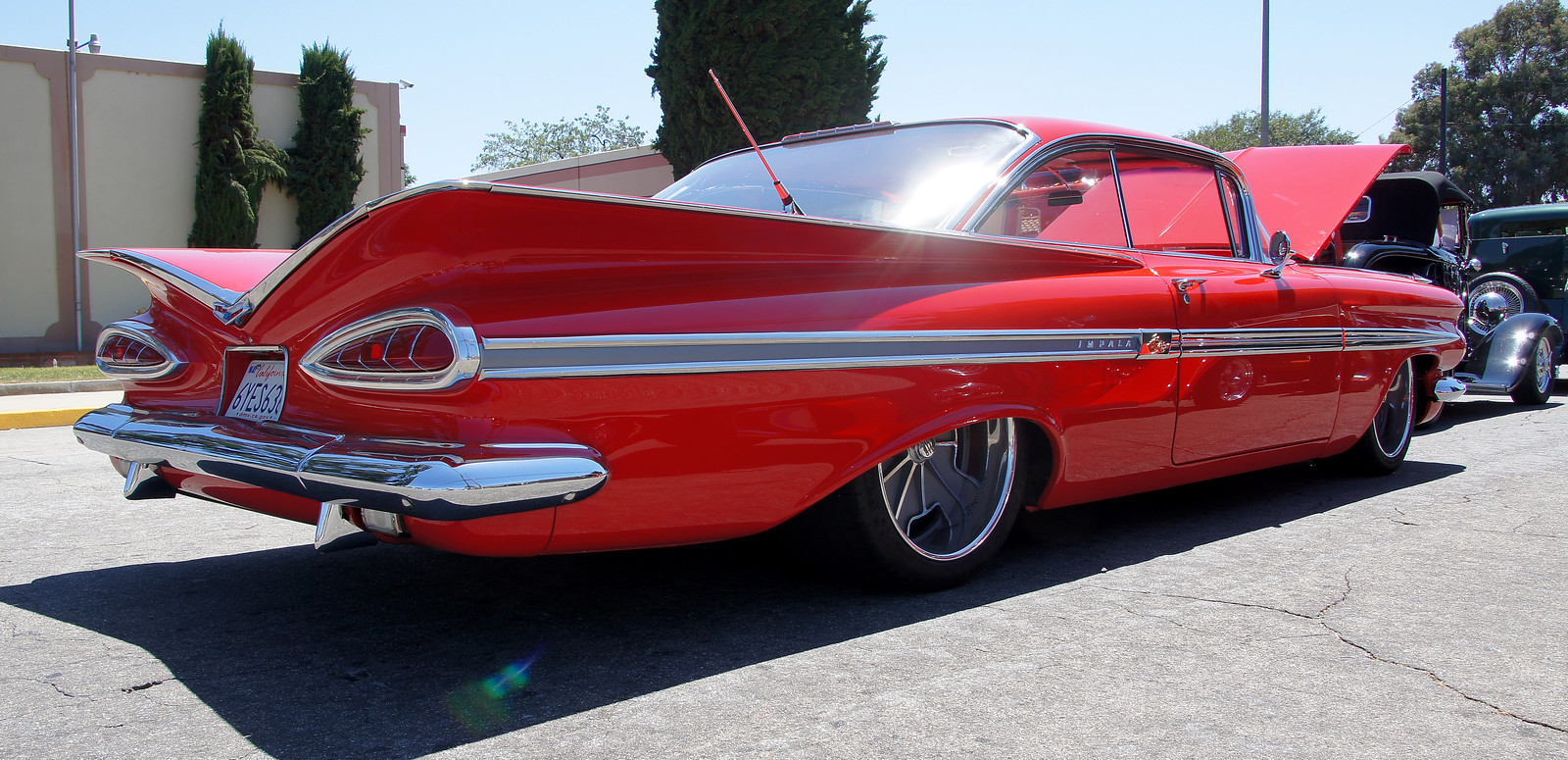
'59 Impala

Model A roadster pickup
Any photo marked 'Tom Davison' is from http://www.socalcarculture.com - great site, well worth checking out.
As the 80s progressed into the 90s the hot rod world seemed to see an upturn, No big surprise, muscle cars were just an old car by now and new cars were.. well.. rubbish.
More and more hot rod shops sprang up with enthusiastic amateurs turning professional, also more parts manufacturers and suppliers started to appear. Part suppliers were nothing new of course but now there were so many - suspension parts, electrical wiring kits, engine mounts, steering columns, even air conditioning systems - almost everything you could think of.
Coddington had established Hot Rods by Boyd in Stanton, CA as well as Boyd Wheels, during this time he really was a leading light. During this time a guy called Sam Foose had a shop that built hot rods but also made film props, his son, Chip helped out in the shop from an early age.
Chip had a real talent for drawing and design and went to college to study design. He then worked for a company that did design work for OEM manufacturers, eventually ending up leading the design side. In 1990 Foose had finally graduated and was working part time for Coddington, the job went full time a few years later and Foose ended up president of Hot Rods By Boyd. During this time he designed wheels and cars, including the Boydster cars, a series of custom bodies built exclusively by Boyd. Based on the early ford roadsters but stretched, chopped, tweaked they certainly created a stir, the Boydster II won AMBR in 1996 (AMBR is an award for Americas Most Beautiful Roadster).

Boydster ii

Boydster iii
Foose is the youngest person ever to be inducted in to the hot rod hall of fame at 31 years old.
I don't know exactly what happened, it seems Foose had financial or business interest in the Boyd company. It went bankrupt, Foose and Coddington fell out. It seems there were some sharp practices, Coddington held on to the wheel company and soon set up again in the shop we all saw on TV.
Also in the 90s another 2nd generation car builder was on his way, having built some cars and received accolades from Hot Rod magazine and Goodguys he formed Rad Rides in the mid 90s, his name ? Troy Trepanier.
90s, we're in Tennessee, Bobby Alloway, a general manager at a Ford dealership quits his job and opens up his hot rod shop. Alloway was already no stranger to top level car building, he'd won the 1985 Ridler award with his '33 Ford Victoria. He lost the entire shop to a fire in 1998, but already had a reputation for really, really nice cars. His trademark look is to use a tyre with lots of sidewall in the rear and less so in the front, giving the cars a rake purely from the tyre height differences. I really like his stuff.

Bobby Alloway
The average street rod in the 80s and 90s was all a bit Miami Vice really. Pastel colours, pinstriping gave way to graphics, the dralon buttoned interiors of the 70s had given way to tweed. As with most of the 80s we'd consider it pretty poor taste now!

A typical 80s/90s street rod, ick!
The escalating costs of the top cars and the relative lack of taste of others turned some people off. They liked what they considered hot rods not street rods. They'd build a traditional looking car, steel wheels, maybe even wired wheels with a beam front end, definitely not a small block engine, they tried to use original parts that the street rodders were throwing away and so on. they soon got the name "low buck" cars, because compared to the high costs of a state of the art street rod, they were.. the street rodders got the name "goldchainers" on account of their show of wealth.
As we said goodbye to the 90s street rods started to become more tasteful - like the Miami Vice jeans the pastel colours were gone as were the dodgy graphics. Thanks to people like Alloway cars started getting a good stance - until now street rods hadn't had the nice rake of a hot rod, but it was coming back.
Foose revamped a Boyster for Chuck Svatos, now renamed the 0032 it won AMBR in 2000. Svatos traded the car to Foose for work on a '32 3 window. Foose sold the 0032 to the Petersen museum and used the money to start Foose Design. In 2002 he won the Ridler with Wes Rydell's '35 Chevy 'Grandmaster'.

Wes Rydell's 'Grandmaster'
For what it is I love the car, graceful lines, its a bit like the 30s european cars. Above all else its just so well executed. Every single panel gap is 1/8th of an inch. There is a build gallery here: http://www.garagescene.net/gallery3/index.php/Buil...
Just a year later he was back with Ron Whiteside's Stallion, a '34 3 window. It took the ridler award. Again a tweaked body and just perfect execution of the build.. Foose was the target that everyone had to beat

Ron Whiteside's Stallion
Build pictures here: http://www.wallesdator.com/Foose%20design/Stallion...
2004 Foose sat out the Ridler, the car he was building for Ken Reister wasn't ready. He was back in 2005 with Reister's car and again took the top trophy. Impression is loosely based on a '36 Ford, but was a scratch built body (by Marcel Deley). I've seen this one up close and its just beautiful, the details are so subtle and its proportions are just right. Looking back, the problem is was this still hot rodding ? you could argue that this was bespoke coachbuilding of luxury cars. For everyone else, how can you beat this ? it sort of left everyone with nowhere to go.

Ken Reister's 'Impression'
Build pics here: http://wallesdator.com/Foose%20design/Impression/P...
Back to Troy Trepanier, in the mid/early 90s he had built a '39 Chevy and took it to some of the big shows, one of the guys he met was George Poteet.
Poteet is a car nut, a very rich car nut. He owns Shelby Cobra #1 and a bunch of other exotic race cars. He's also a hot rod nut and is permanently having cars built - at least 2 or 3 a year, every year.
Poteet asked Troy what he was going to do next, Troy said he wanted to do a Plymouth Savoy and already had ideas for the changes. Poteet replied that he'd had one of those years ago and commissioned the car.
Troy had already chatted to Chip months before and whilst they were talking on the phone Chip had scribbled a drawing and faxed it to Troy.
So, here's a 1954 Plymouth:

Here's the car that Troy built, nicknamed Sniper

This car really put Troy on the map, first of all it was a custom - the custom/kustom scene had been quiet for a while, it'd sort have gone out of fashion. Firstly the car was top quality work, but it also had another trick up its sleeve.. that swoopy body was covering a full Dodge Viper drivetrain. Troy had the idea before starting the car, but this was mid 90s, the Viper a supercar - how do you get hold of one without selling the kids ?
Simple, you phone Chrysler and ask for one. Thats exactly what Troy did, a short while later they said "Come up here and bring a trailer". They gave him a development car "Use what you want, just bring the rest back so we can crush it".
Cars for Roger Ritzow (traditional '32 roadster with lots of modern tricks), Glen Grozich ('62 Chevy with 1200hp from its twin turbo engine).
Roger Ritzow's '32 Roadster

Glenn Grozich's '62 Chevy
Then some guy called Ross Myers asks Troy to build him a '36 Ford. Myers had owned the car since he was a teenager. Named First Love the car won the 2007 Ridler award. You'll note that the car although sporting quite a few body mods is very representable of the '36 Ford - quite a change from the Foose car just 2 years before.

Ross Myer's '36 Ford
There are a few build pictures here: http://www.radrides.com/photos/gallery/images?albu...
The entire underside of the car is just amazing, pretty much the entire lot was machined in house, the brakes, the hubs, wishbones, axle casing, you name it.
Some good pics of it here : http://www.pinupsandkustoms.com/blog/rad-rides-by-... Beware - some of the background images on that site are NSFW.
Again its attention to detail and high quality work. Foose crawled all over the car when it was unveiled and proclaimed himself glad that he wasn't competing against it. A year alter I watched Roy Brizio do pretty much the same with Troy.
There is a lot to look at with this car - some cars you take a good look at and you've seen it. This one each time you happened to walk by you noticed something else, a little detail here and there. I could see there was something going on with the wheels, took me a while and a chat with a mate to figure it out - the wheels are different size front to back (not unusual) but they've changed the PCD of the wheel in proportion to its diameter, just another little detail..

Troy & Roy Brizio look over First Love at the 2008 Grand National Roadster show, note the removed shoes in the background

These cars are what I call the ultra street rods at their height, just incredible workmanship and quality. It wasn't to last...
Meantime some of the low buck guys had gone one step further and were building rat rods. This all started as an antithesis to the high buck stuff remember - criticism was given for trailering street rods to shows (which had been going on years), liberal over use of billet (machined aluminium parts) and so on. The irony is that as rat rods got more and more extreme, they were being trailered to shows as they were undriveable, whilst street rods in the 80s and early 90s were a bit tasteless I'd venture that rat rods are no better, but I guess thats subjective.
Basically the rules of rat rod building are : find some rusty car bits, throw them together, cut up anything you can and then look cool.. The more dangerous the better - we're talking no floors, no front brakes, suicide front end setups and so on.
To be fair the "rat rod" name gets thrown around a lot, a rusty truck isn't a rat rod, a flat black roadster or coupe might be "old skool" but it isn't a rat rod.
I don't really have much time for rat rods and the arrogant attitude that some owners have. I'm sure there are some safe, well built cars out there but christ there is lots of dangerous junk too. Asthetically they do little for me:


Over the past maybe 10 years things have met in the middle a bit, rat rods seem to be less prevalent, the high end stuff is a bit more subtle and low key, traditional looking cars are popular and pretty much everyone is keeping original trim and detail parts that might have been removed previously. Some of the guys building rat rods have grown up a bit and have stopped doing dumb stuff, even the "old skool" boys have got tired of flat black paint with red wheels...
Apologies for the long post, I wanted to get the timeline stuff finished, if you guys are interested there is stacks more history stuff - people who owned or built cars or made parts, styles, personalities and so on but we can't hope to cover it all so I'm sure bits and pieces will come up as we go.
So, am I talking to myself yet ? Does anyone have any questions or stuff you'd like to know more about ?
Random pictures..

John Mumford's Brizio built '27 T roadster, 2012 AMBR winner

Ron Cizek's Checkered Past '40 Ford. Built by Andy Leach who is an ex- Rad Rides employee. 2013 Ridler winner

Bobby Alloway built '32 Vicky, 2013 Goodguys street rod of the year

60s inspired T bucket

Model A roadster

'32 3 WIndow in build at SoCal Speedshop

'36 Roadster
'64 Falcon

'37 Sedan
'32 3 window

'59 Impala
Model A roadster pickup
Any photo marked 'Tom Davison' is from http://www.socalcarculture.com - great site, well worth checking out.
Edited by Crafty_ on Sunday 6th July 20:00
Edited by Crafty_ on Sunday 6th July 20:24
Some high end stuff doesn't get driven for maybe a year or two because they are contracted to be on a tour of shows. I can remember a Rad Rides car that was for sale part built, part of the deal was the show contract.
After that, they do get driven, all of the 3 Foose cars above are driven, about 6-8 years ago there was a TV series called Rides that did some episodes on hot rod stuff, one of which featured Stallion & Grandmaster being prepped for a show across country (IIRC Phoenix), they being driven there.
I think you mean one of these Volvos ? all built by the same chap in Sweden, never really heard much more about them other than he worked for Volvo and ransacked parts bins to build them !
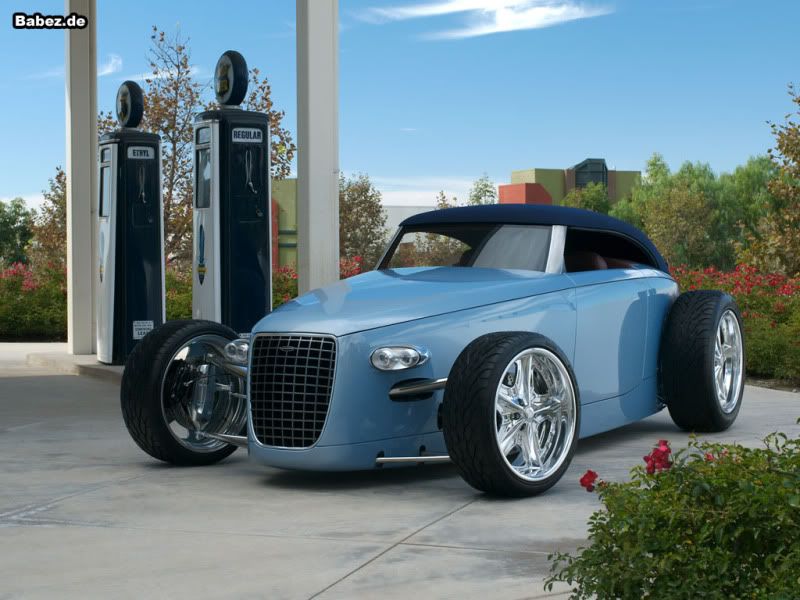

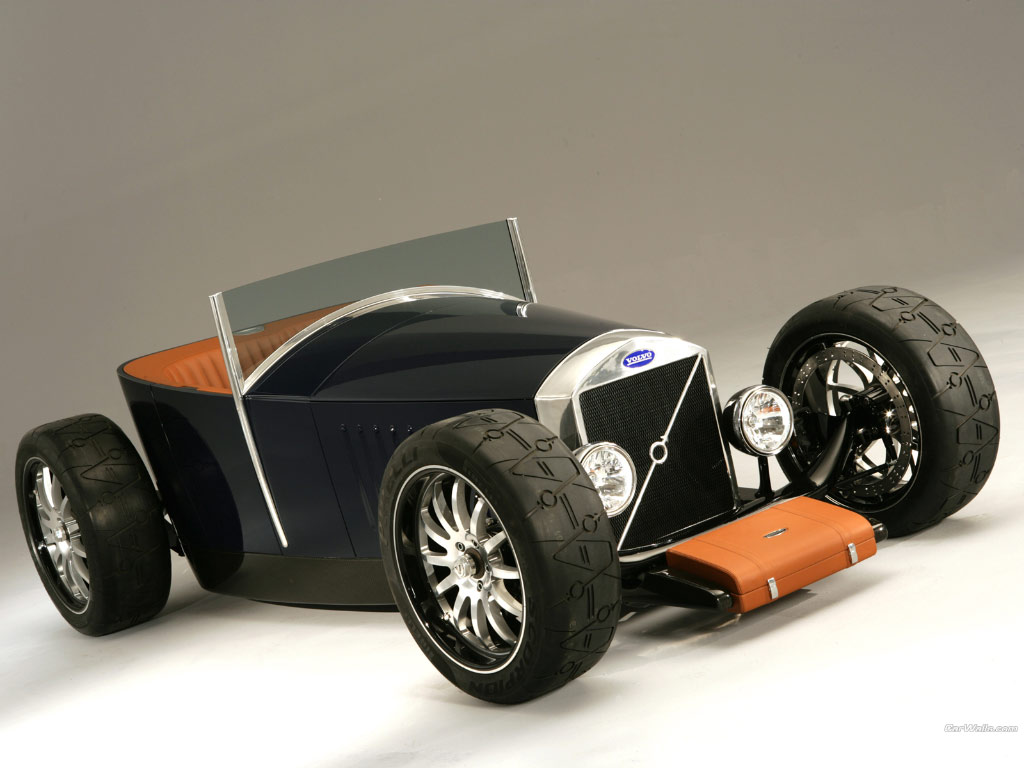
After that, they do get driven, all of the 3 Foose cars above are driven, about 6-8 years ago there was a TV series called Rides that did some episodes on hot rod stuff, one of which featured Stallion & Grandmaster being prepped for a show across country (IIRC Phoenix), they being driven there.
I think you mean one of these Volvos ? all built by the same chap in Sweden, never really heard much more about them other than he worked for Volvo and ransacked parts bins to build them !



I've been slacking, need to add a post about UK history, but meantime do we all remember this ?
http://www.ebay.co.uk/itm/1972-FORD-HOT-ROD-roadst...
http://www.ebay.co.uk/itm/1972-FORD-HOT-ROD-roadst...
Escort3500 said:
Have we had this yet?
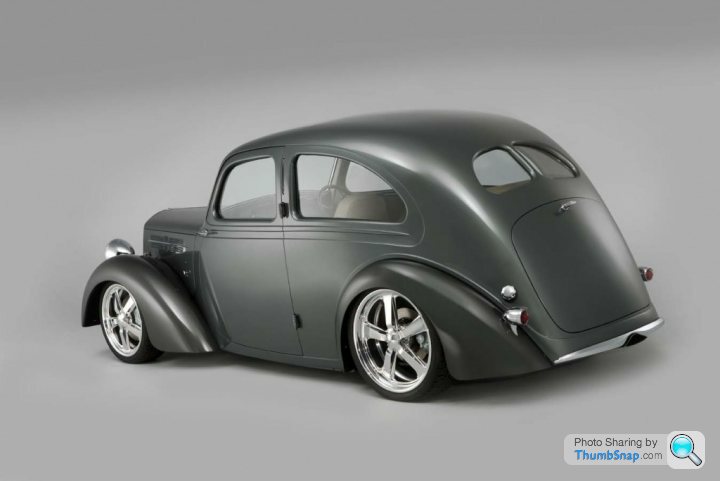
Built by Dave Rothwell, one of the finest hot rod builders in the country IMHO. Still enjoy looking at this at shows even though it's been around for a good few years.
Up for sale too I believe.
Built by Dave Rothwell, one of the finest hot rod builders in the country IMHO. Still enjoy looking at this at shows even though it's been around for a good few years.
Sad news, some pages back we covered the start of hot rodding and mentioned the legendary Pierson coupe, sadly Dick Pierson passed away last week, I suspect that the magazines will run articles when new issues come out.
Found a video of Johnny Martinez's pickup via rodauthority.com : http://youtu.be/ojcRkKJ_F90
Edited by Crafty_ on Wednesday 16th July 22:52
Escort3500 said:
Where? 
my mistake, I was looking at an old advert 

Here's a pic of the Pierson coupe after Bruce Meyer had asked Pete Chapouris to restore it to 1950 configuration. Bruce gathered up everyone who had been involved with the car over the years.

You might recognise some faces there, sadly nearly half of the group have since passed away.
Some more pictures of the coupe "back in the day" on kustomrama : http://www.kustomrama.com/index.php?title=Pierson_...
Hot rodding has probably been part of British car culture for as long as it has in the USA, albeit under different names..
As the car came about, people wanted to race them. We had no dry lakes of course, but we did have roads that could be closed off for small sections, cars could compete once at a time against the clock, they became known as speed trials and ran all over the country, few survive, the most famous being the Brighton Speed Trials, which was first held in 1905.
Competitors were soon creating specials, stripped of any unnecessary bodywork, improved engine performance.. it all sounds pretty familiar. A special then, was a hot rod in all but name.
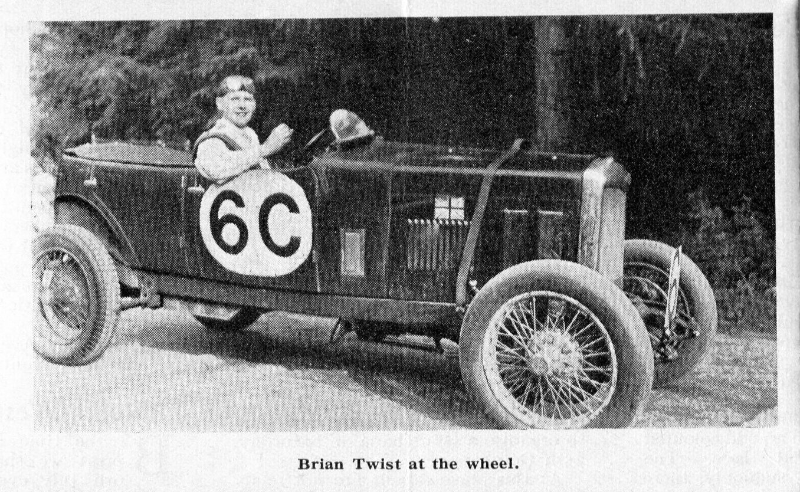
An early Riley based special
This soon expanded to hill climb speed trials, held on unpaved roads or even simply on fields the idea was the same - beat the clock.
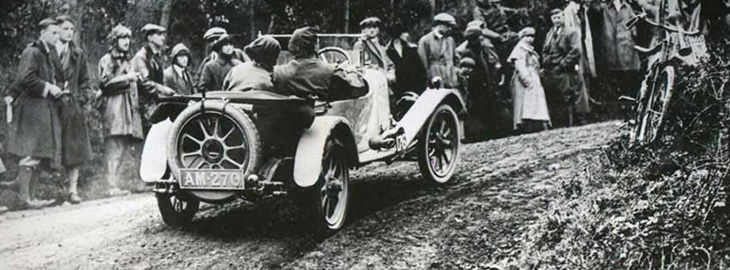
A Singer competing in a hillclimb, circa 1915
Sydney Allard was a very keen hill climber, starting in the 1930s the son of a builder he owned the confusingly named Adlards Motors. This was primarily a normal garage (later a Ford main dealer) but by the late 30s was building hillclimb specials. During the war they overhauled army vehicles but were soon producing specials again by the 50s.
As the years rolled on into the 60s Sydney began reading hot rod magazine and decided to build a dragster. He obtained a chrysler hemi engine from the USA aong with a supercharger from Mooneyes and built this

The allard dragster
He was in good company, in the late 50s people like Ken Cooper and Peter Bartlett were discovering the world of hot rods from magazines and US servicemen. They formed clubs like 'The Sprinters' and 'The Highwaymen'. Another early pioneer was Allan 'bootsie' Herridge. These guys were the start of drag racing and hot rodding in the UK. In the early 60s the British Hot Rod Association (BHRA) was formed, this was really a collection of the clubs that were slowly appearing across the country.
By the mid 60s there were regular drag racing meets at Blackbushe airport. At Easter in 1966 an old US Bomber base a few miles away from Wellingborough opened as a drag strip, called Santa Pod (a mixture of the infamous american track Santa Ana and the nearby village of Poddington) drag racing in the UK now had a home. The sport continues to grow and Santa Pod is acknowledged as one of, if not the best strip in Europe. There is some video of that first meet here: http://youtu.be/cFxyhactqr8?list=UUG1eoynkJaspWHOJ...
We could go on forever, following drag racing but I'd suggest that belongs in the appropriate forum here on PH, pop in and say hello, they're a friendly bunch in there
Meantime, on the road more and more hot rods were appearing, here's a pair of ord Model Y's from around 1964 or so. Owners were Clive Lingard and Mike Butler, both members of the Drag Hot Rod Club in Manchester

Another picture, the yellow '37 is Ken Cooper's car, the '32 owned by Alan Doyle. Not sure about Alan but Ken has quite a history in drag racing slingshots.
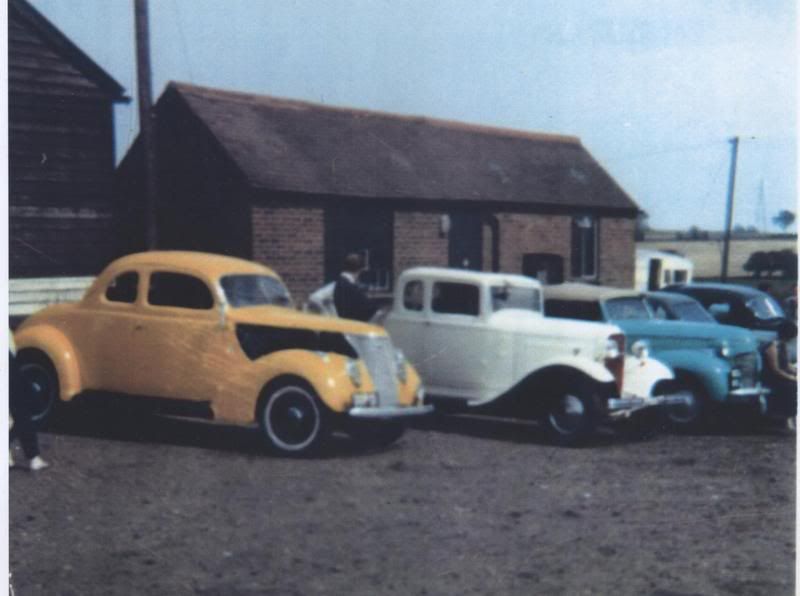
Advert for the first meeting of the BHRA in '63. This is on the side of a '54 Oldsmobile that was converted to a pickup and was the shop truck for Spa Engineering in South London. That picture comes from here: http://www.ukdrn.co.uk/forum/viewtopic.php?f=13&am... quite a few more on that link.

This Ford truck was kustomised by Jeff Jago in the mid 60s. I guess its a British version of Ala Kart.
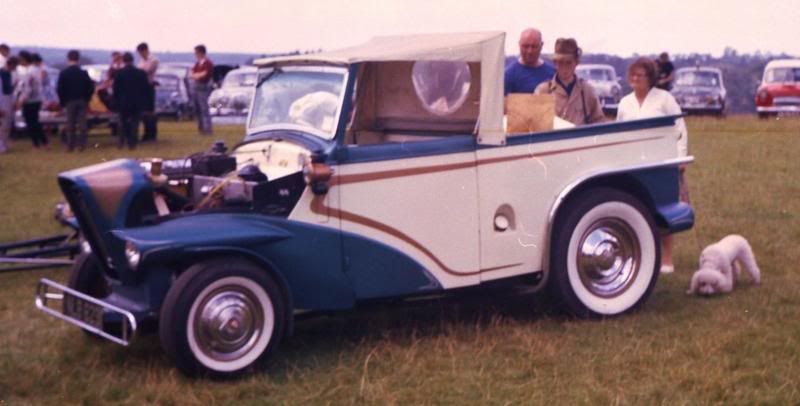
Jeff Jago was instrumental in hot rodding in the late 60s. He put together a kit so you could build your own Model T hot rod, a fibreglass body and a fabricated chassis, mostly using components from British cars to make it affordable. Later on Jago produced '32 5 window bodies.

Early Jago T, I think one of our members may recognise it?
From the mid 60s there were hot rod ( or "custom car" ) shows, including a BHRA two day show in the car park in Hyde Park.
It was around this time that Jeff Beck got interested in hot rods, as his career blossomed so did his love of hot rods. He's good friends with Andy & Roy Brizio. Beck actually builds his own stuff and owns a couple of Brizio built cars too, if you avoid the naffness of the intro etc there are a couple of videos with Beck here : http://www.carcrazycentral.com/VideoResults.aspx?q... he talks about getting in to the hobby and some of his cars.
He wasn't the only musician into hot rods either, John Bonham owned a T Bucket, the car was imported by Beck and then sold to Bonham. I believe it still exists..
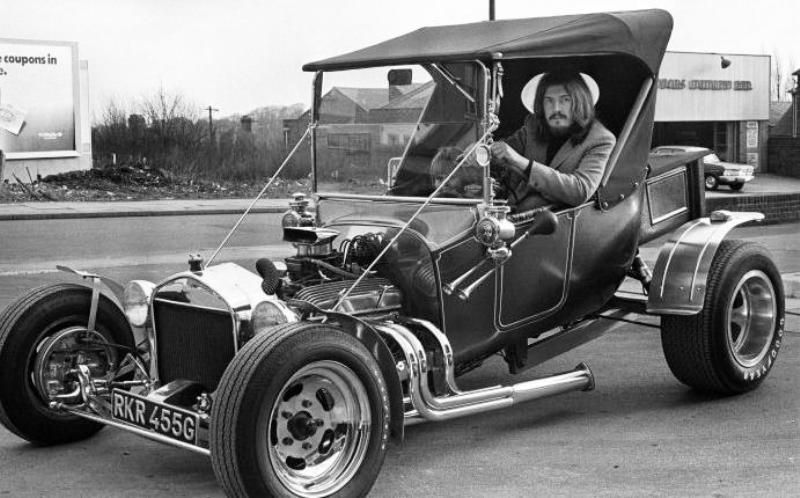
John Bonham in the Boston Strangler T
Drag racing and hot rodding here were slowly growing up together. In the early 70s an offshoot of the NDRC (National Drag Racing Club) was created, called the Roadster Register it was meant to be for road going cars. By 1972 it had 12 members, despite few (if any) actually owning a roadster. A meeting was held and the register disbanded, instead a completely separate club was created. The new club was named the NSRA (National Street Rod Association), despite it having no ties with the club in the USA. On the committee was Mickey Bray, who was to build "Pinball Wizard", a Ford Pop later owned by Paul McCartney.

Pinball Wizard
The aim of the NSRA was to promote hot rodding and soon set about organising shows. By chance they discovered Billing Aquadrome in 1973 and held a show there, the Billing Fun Run has run every year since and is a big part of the history of hot rods in the UK.
Model Ts were the car to build. Nick Butler build Nykilodean, Gary Belcher but his jag V12 powered T that now lives in the Haynes Museum.
.jpg)
Nykilodean, with builder Nick Butler
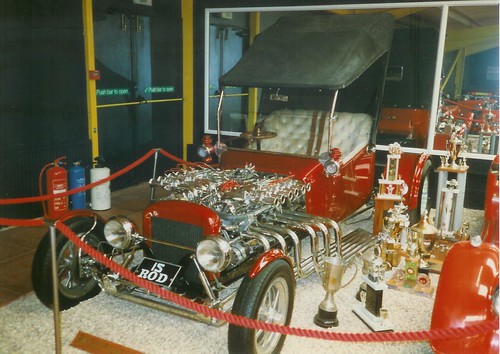
Gary Belcher's V12 T
These cars, along with the famed Butler built Andromeda T really saw rodding take off in the UK. Jago was supplying the '32 bodies, Nick Butler had gone into business as Auto Imagination (and is still going today). More and more people started building cars.
Along with Model Ts the Ford Pop was a mainstay, Popcorn as above, Barry Treacy's "Mister T" appeared in about '72 with an.. well, shall we say interesting paint job!

Barry Treacy's Mister T Pop
As the 80s arrived so did the american influences, so more and more american cars started to appear, along with the new pro street and high tech styles.
Looking back it seems there were many shows to attend during this time period - Belle Vue and Olympia were indoor shows, Garys Picnic wa a favourite of many. the NASC (Nation Association Of Street Clubs) ran the Nationals at Bruntingthorpe. The NSRA Billing and various other shows. The South coast Victory Wheelers club put on a show on Hayling Island's The Oven campsite that appears to have always been over subscribed. In 1982 organisers of the British Grand Prix even asked for a small group of hot rods to take part in a parade before the race.
Here's Streetrod's Beetle at the Brungthorpe Nats, probably the mid 80s by the looks of it

Streetrod's Beetle

Brizey's '32 hiboy, sometime in the late 70s
Today the scene seems as strong as ever, with lots of fresh cars appearing and the shows always busy. There has been an awful lot of history in the meantime that I simply can't cover in one post. So you lot must have some pictures you can put up ??
Oh and can anyone explain how the climbing of tent poles began ? For those not aware of this practice, you don't want to know! trust me!
For drag racing in the UK buy this book : http://www.amazon.co.uk/Crazy-Horses-History-Briti... Its pretty much the authoritative book on drag racing in the UK and was used as a source for this post
Also there are many pictures at : http://www.theaccelerationarchive.co.uk/
I don't think its available to buy, but if you have a friend who is an NSRA member ask if you can borrow their copy of "Keeping the dream alive". This was a book written in 2012 by Nick Brooke-Langham to celebrate 40 years of the NSRA, distributed to all NSRA members, it charts the history of the club and was a useful reference point for this post!
Also check out Nick Pettit's site here: http://www.timetraveldvds.co.uk/index.html Lots of photos and a few clips from the DVDs that Nick sells.
If you want to see what its all about in person the NSRA Supernationals are held at Old Warden, near Biggleswade in Bedfordshire 1st - 3rd August. The Sunday (3rd August) is open to day visitors and will cost £8 for entry. It should give you a little glimpse of the hobby and should have a great turnout if the warm weather continues!
Old Warden is here : https://www.google.co.uk/maps/place/Shuttleworth+C... look for NSRA signs that will direct you to the relevant gate. NSRA info here: http://www.nsra.org.uk/nsra-hot-rod-supernationals...
Photos by Nick Grant from last year here : https://www.flickr.com/photos/grantgb/sets/7215763...
As the car came about, people wanted to race them. We had no dry lakes of course, but we did have roads that could be closed off for small sections, cars could compete once at a time against the clock, they became known as speed trials and ran all over the country, few survive, the most famous being the Brighton Speed Trials, which was first held in 1905.
Competitors were soon creating specials, stripped of any unnecessary bodywork, improved engine performance.. it all sounds pretty familiar. A special then, was a hot rod in all but name.

An early Riley based special
This soon expanded to hill climb speed trials, held on unpaved roads or even simply on fields the idea was the same - beat the clock.

A Singer competing in a hillclimb, circa 1915
Sydney Allard was a very keen hill climber, starting in the 1930s the son of a builder he owned the confusingly named Adlards Motors. This was primarily a normal garage (later a Ford main dealer) but by the late 30s was building hillclimb specials. During the war they overhauled army vehicles but were soon producing specials again by the 50s.
As the years rolled on into the 60s Sydney began reading hot rod magazine and decided to build a dragster. He obtained a chrysler hemi engine from the USA aong with a supercharger from Mooneyes and built this

The allard dragster
He was in good company, in the late 50s people like Ken Cooper and Peter Bartlett were discovering the world of hot rods from magazines and US servicemen. They formed clubs like 'The Sprinters' and 'The Highwaymen'. Another early pioneer was Allan 'bootsie' Herridge. These guys were the start of drag racing and hot rodding in the UK. In the early 60s the British Hot Rod Association (BHRA) was formed, this was really a collection of the clubs that were slowly appearing across the country.
By the mid 60s there were regular drag racing meets at Blackbushe airport. At Easter in 1966 an old US Bomber base a few miles away from Wellingborough opened as a drag strip, called Santa Pod (a mixture of the infamous american track Santa Ana and the nearby village of Poddington) drag racing in the UK now had a home. The sport continues to grow and Santa Pod is acknowledged as one of, if not the best strip in Europe. There is some video of that first meet here: http://youtu.be/cFxyhactqr8?list=UUG1eoynkJaspWHOJ...
We could go on forever, following drag racing but I'd suggest that belongs in the appropriate forum here on PH, pop in and say hello, they're a friendly bunch in there

Meantime, on the road more and more hot rods were appearing, here's a pair of ord Model Y's from around 1964 or so. Owners were Clive Lingard and Mike Butler, both members of the Drag Hot Rod Club in Manchester
Another picture, the yellow '37 is Ken Cooper's car, the '32 owned by Alan Doyle. Not sure about Alan but Ken has quite a history in drag racing slingshots.

Advert for the first meeting of the BHRA in '63. This is on the side of a '54 Oldsmobile that was converted to a pickup and was the shop truck for Spa Engineering in South London. That picture comes from here: http://www.ukdrn.co.uk/forum/viewtopic.php?f=13&am... quite a few more on that link.

This Ford truck was kustomised by Jeff Jago in the mid 60s. I guess its a British version of Ala Kart.

Jeff Jago was instrumental in hot rodding in the late 60s. He put together a kit so you could build your own Model T hot rod, a fibreglass body and a fabricated chassis, mostly using components from British cars to make it affordable. Later on Jago produced '32 5 window bodies.

Early Jago T, I think one of our members may recognise it?
From the mid 60s there were hot rod ( or "custom car" ) shows, including a BHRA two day show in the car park in Hyde Park.
It was around this time that Jeff Beck got interested in hot rods, as his career blossomed so did his love of hot rods. He's good friends with Andy & Roy Brizio. Beck actually builds his own stuff and owns a couple of Brizio built cars too, if you avoid the naffness of the intro etc there are a couple of videos with Beck here : http://www.carcrazycentral.com/VideoResults.aspx?q... he talks about getting in to the hobby and some of his cars.
He wasn't the only musician into hot rods either, John Bonham owned a T Bucket, the car was imported by Beck and then sold to Bonham. I believe it still exists..

John Bonham in the Boston Strangler T
Drag racing and hot rodding here were slowly growing up together. In the early 70s an offshoot of the NDRC (National Drag Racing Club) was created, called the Roadster Register it was meant to be for road going cars. By 1972 it had 12 members, despite few (if any) actually owning a roadster. A meeting was held and the register disbanded, instead a completely separate club was created. The new club was named the NSRA (National Street Rod Association), despite it having no ties with the club in the USA. On the committee was Mickey Bray, who was to build "Pinball Wizard", a Ford Pop later owned by Paul McCartney.

Pinball Wizard
The aim of the NSRA was to promote hot rodding and soon set about organising shows. By chance they discovered Billing Aquadrome in 1973 and held a show there, the Billing Fun Run has run every year since and is a big part of the history of hot rods in the UK.
Model Ts were the car to build. Nick Butler build Nykilodean, Gary Belcher but his jag V12 powered T that now lives in the Haynes Museum.
.jpg)
Nykilodean, with builder Nick Butler

Gary Belcher's V12 T
These cars, along with the famed Butler built Andromeda T really saw rodding take off in the UK. Jago was supplying the '32 bodies, Nick Butler had gone into business as Auto Imagination (and is still going today). More and more people started building cars.
Along with Model Ts the Ford Pop was a mainstay, Popcorn as above, Barry Treacy's "Mister T" appeared in about '72 with an.. well, shall we say interesting paint job!

Barry Treacy's Mister T Pop
As the 80s arrived so did the american influences, so more and more american cars started to appear, along with the new pro street and high tech styles.
Looking back it seems there were many shows to attend during this time period - Belle Vue and Olympia were indoor shows, Garys Picnic wa a favourite of many. the NASC (Nation Association Of Street Clubs) ran the Nationals at Bruntingthorpe. The NSRA Billing and various other shows. The South coast Victory Wheelers club put on a show on Hayling Island's The Oven campsite that appears to have always been over subscribed. In 1982 organisers of the British Grand Prix even asked for a small group of hot rods to take part in a parade before the race.
Here's Streetrod's Beetle at the Brungthorpe Nats, probably the mid 80s by the looks of it

Streetrod's Beetle

Brizey's '32 hiboy, sometime in the late 70s
Today the scene seems as strong as ever, with lots of fresh cars appearing and the shows always busy. There has been an awful lot of history in the meantime that I simply can't cover in one post. So you lot must have some pictures you can put up ??
Oh and can anyone explain how the climbing of tent poles began ? For those not aware of this practice, you don't want to know! trust me!
For drag racing in the UK buy this book : http://www.amazon.co.uk/Crazy-Horses-History-Briti... Its pretty much the authoritative book on drag racing in the UK and was used as a source for this post

Also there are many pictures at : http://www.theaccelerationarchive.co.uk/
I don't think its available to buy, but if you have a friend who is an NSRA member ask if you can borrow their copy of "Keeping the dream alive". This was a book written in 2012 by Nick Brooke-Langham to celebrate 40 years of the NSRA, distributed to all NSRA members, it charts the history of the club and was a useful reference point for this post!
Also check out Nick Pettit's site here: http://www.timetraveldvds.co.uk/index.html Lots of photos and a few clips from the DVDs that Nick sells.
If you want to see what its all about in person the NSRA Supernationals are held at Old Warden, near Biggleswade in Bedfordshire 1st - 3rd August. The Sunday (3rd August) is open to day visitors and will cost £8 for entry. It should give you a little glimpse of the hobby and should have a great turnout if the warm weather continues!
Old Warden is here : https://www.google.co.uk/maps/place/Shuttleworth+C... look for NSRA signs that will direct you to the relevant gate. NSRA info here: http://www.nsra.org.uk/nsra-hot-rod-supernationals...
Photos by Nick Grant from last year here : https://www.flickr.com/photos/grantgb/sets/7215763...
Gassing Station | General Gassing | Top of Page | What's New | My Stuff




